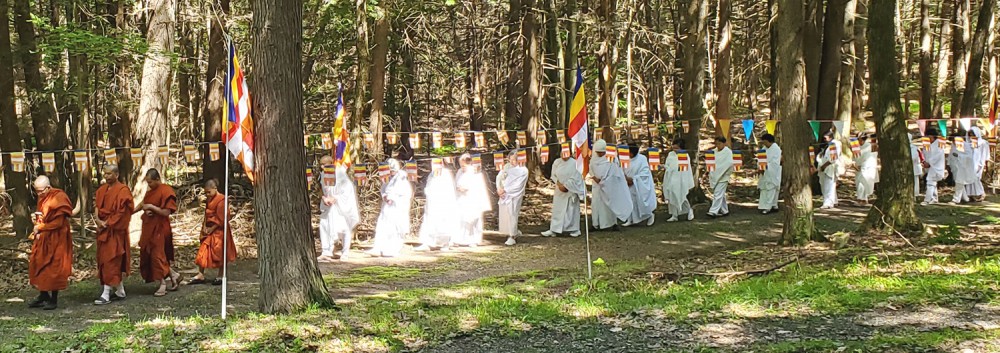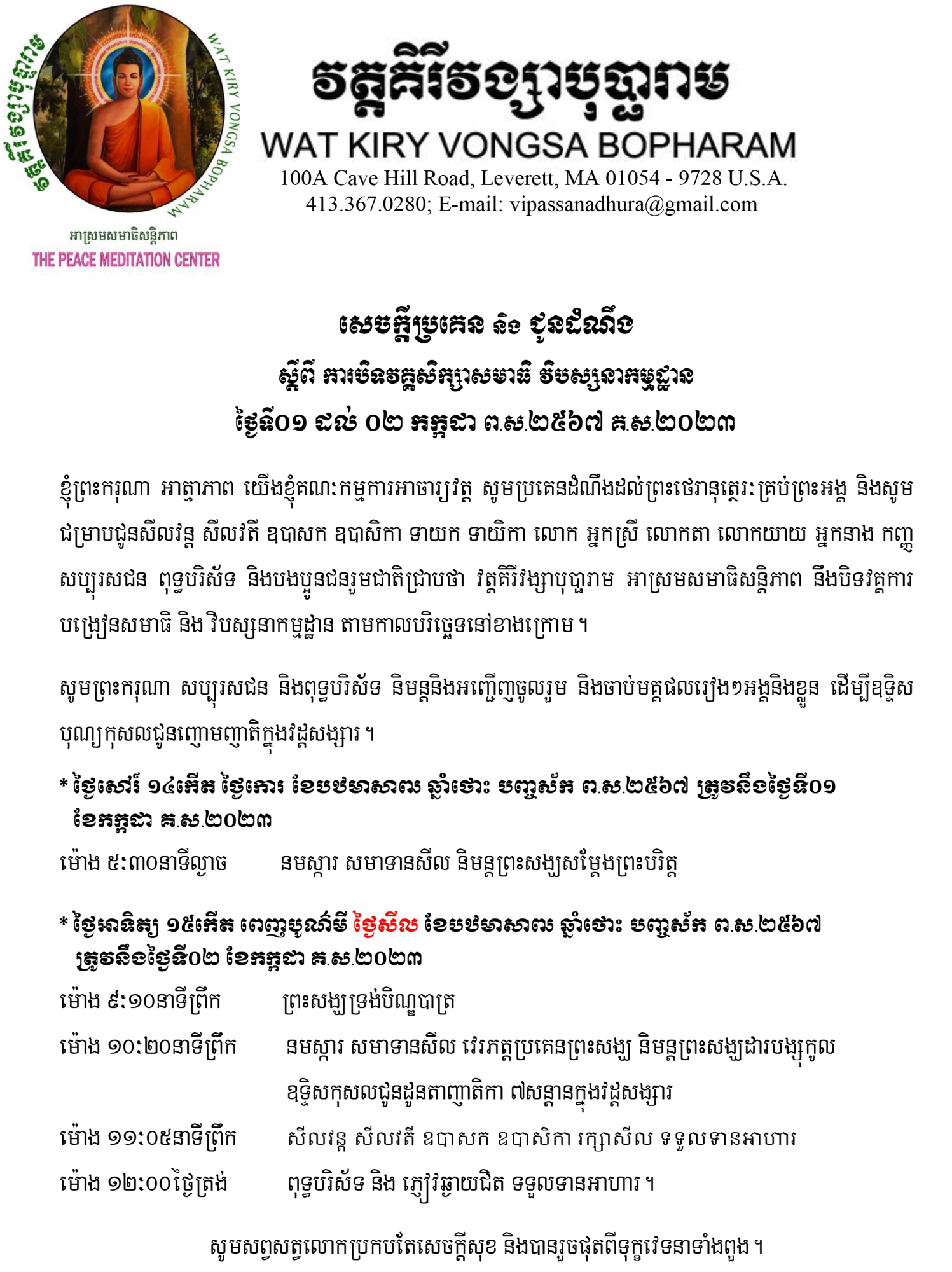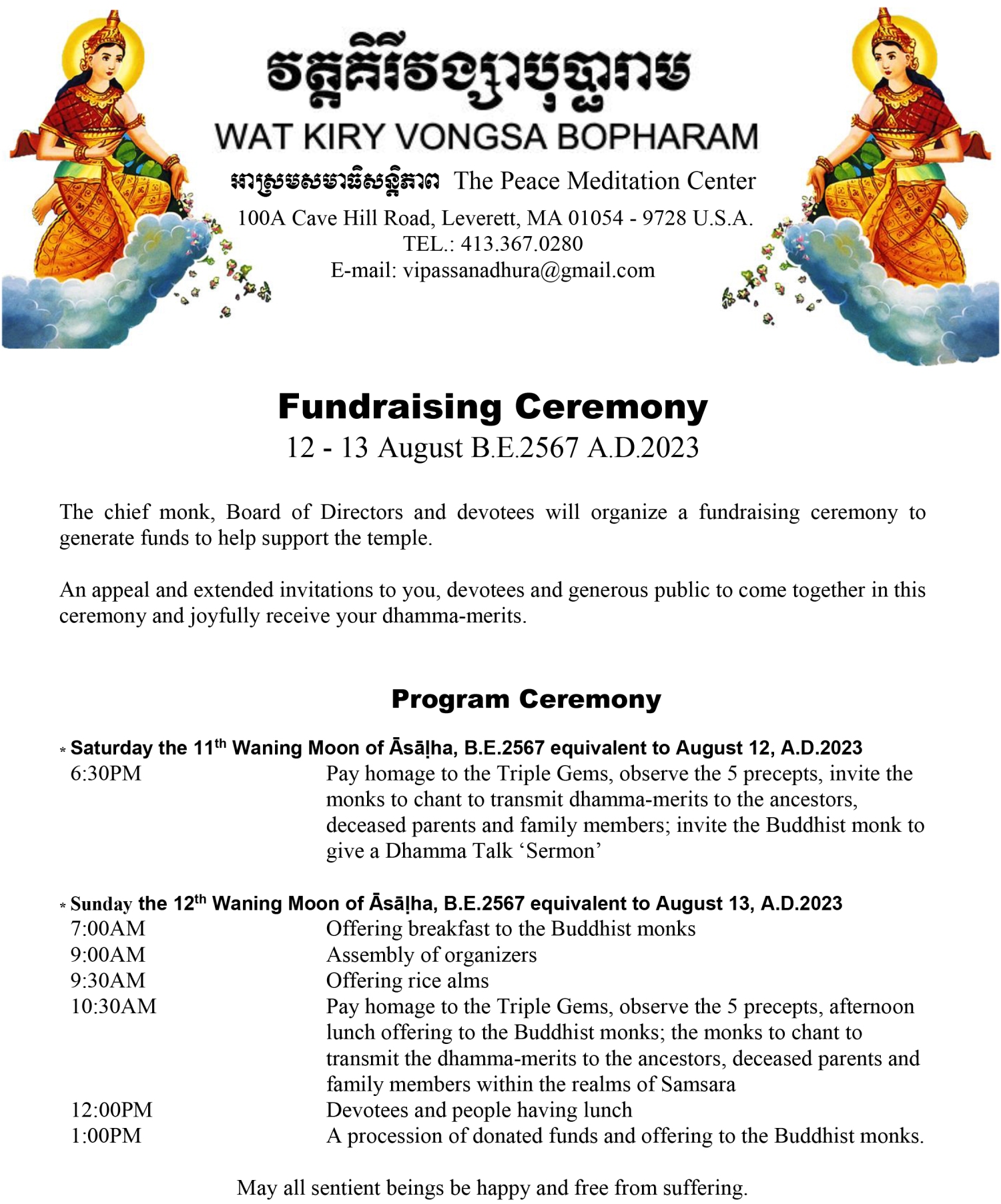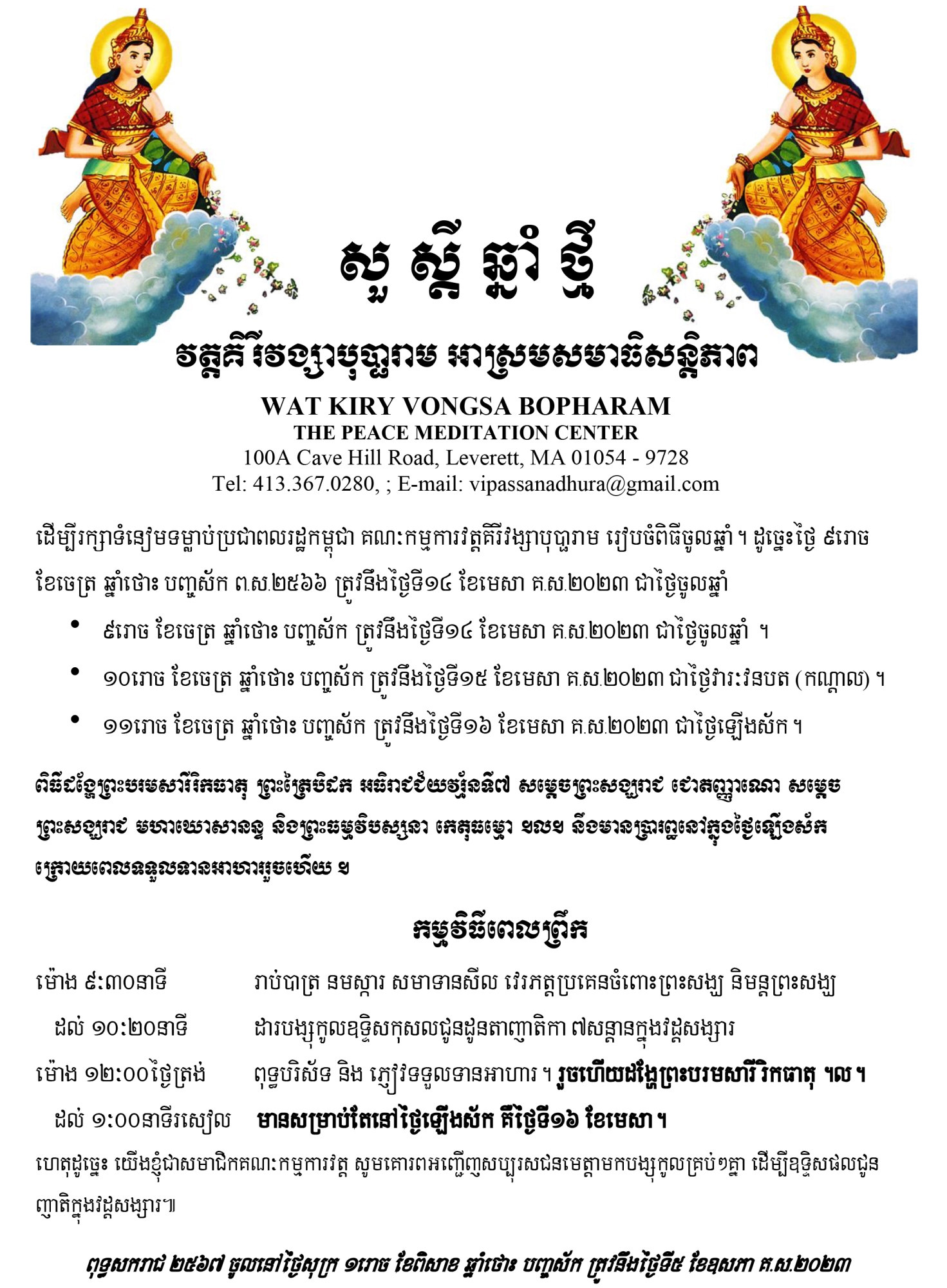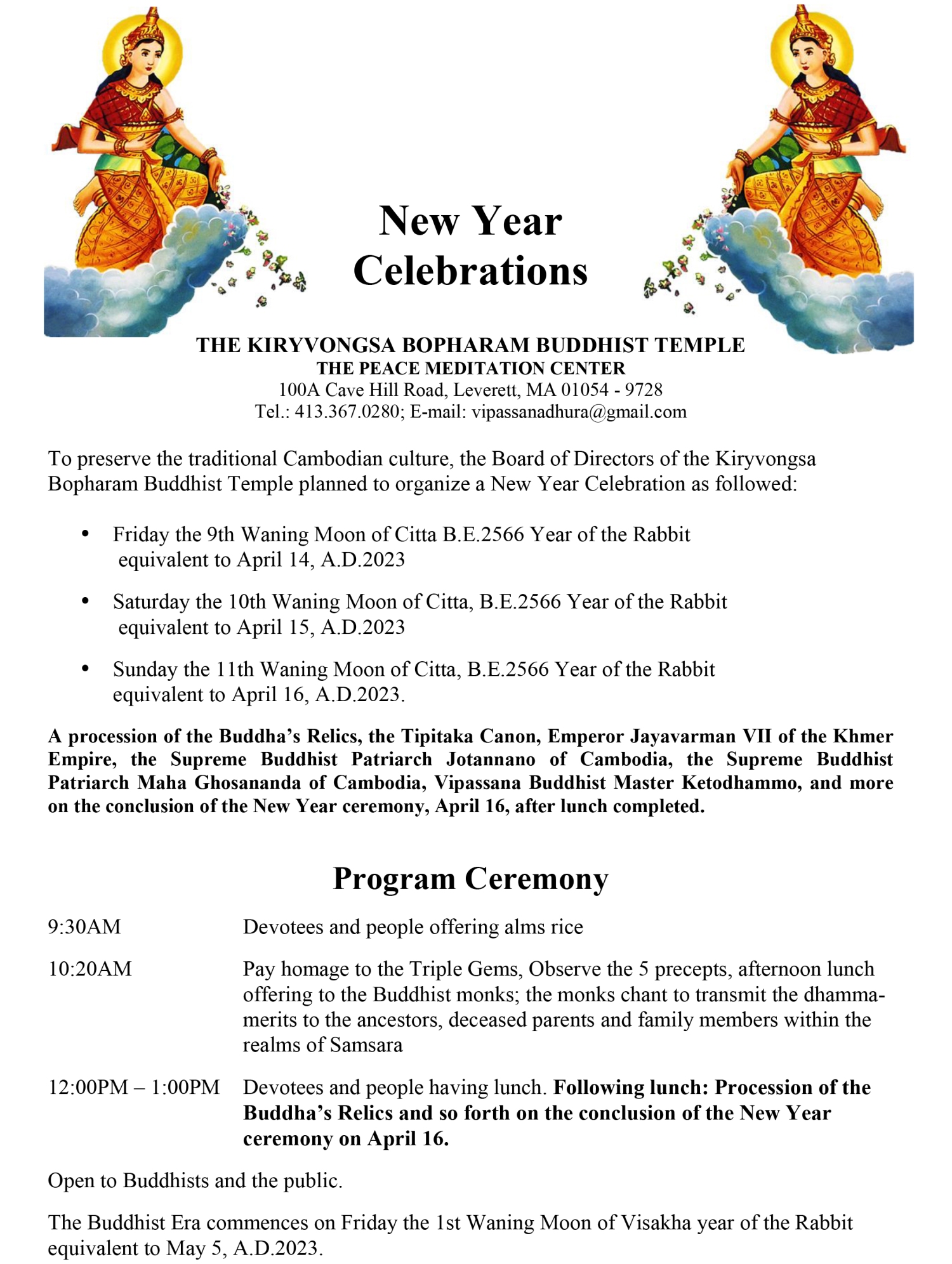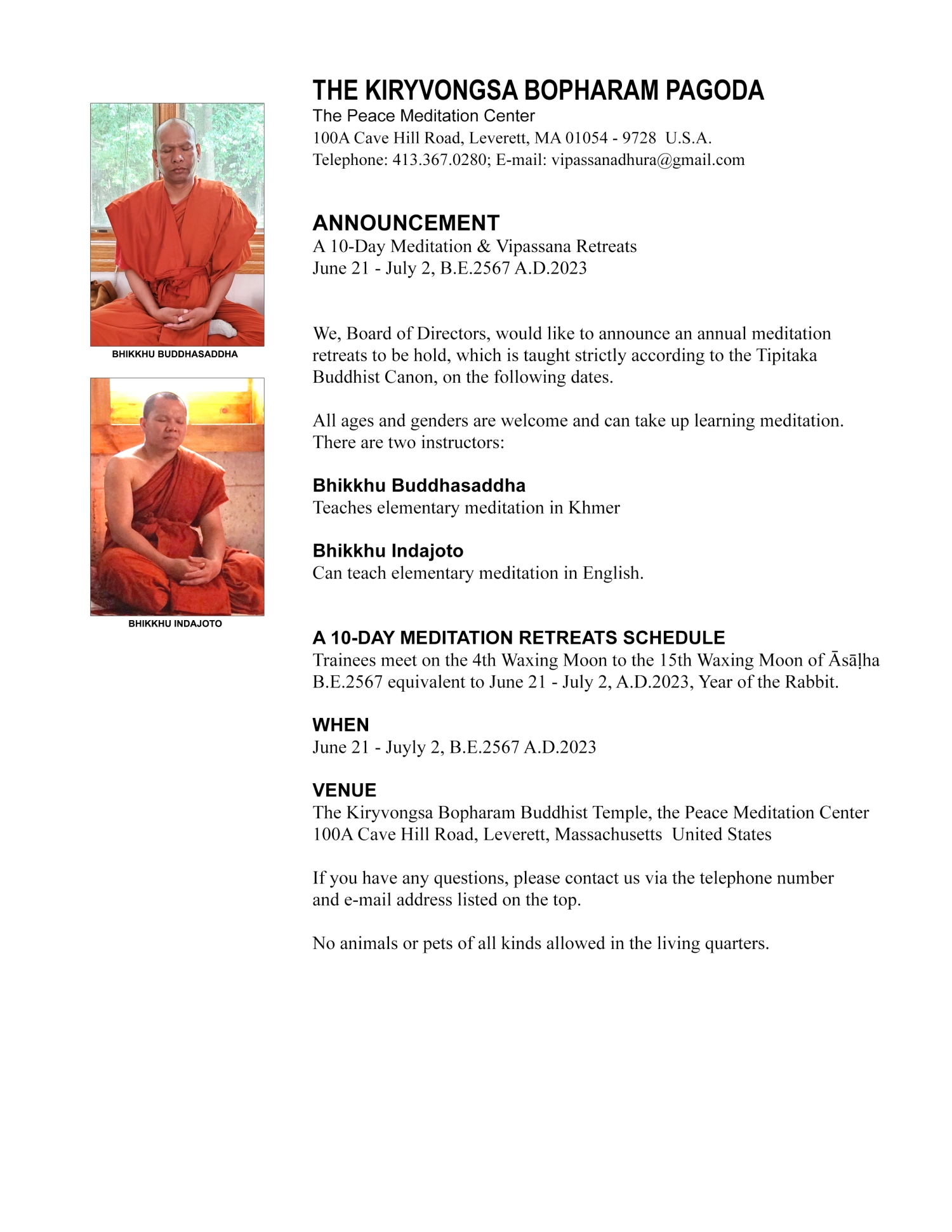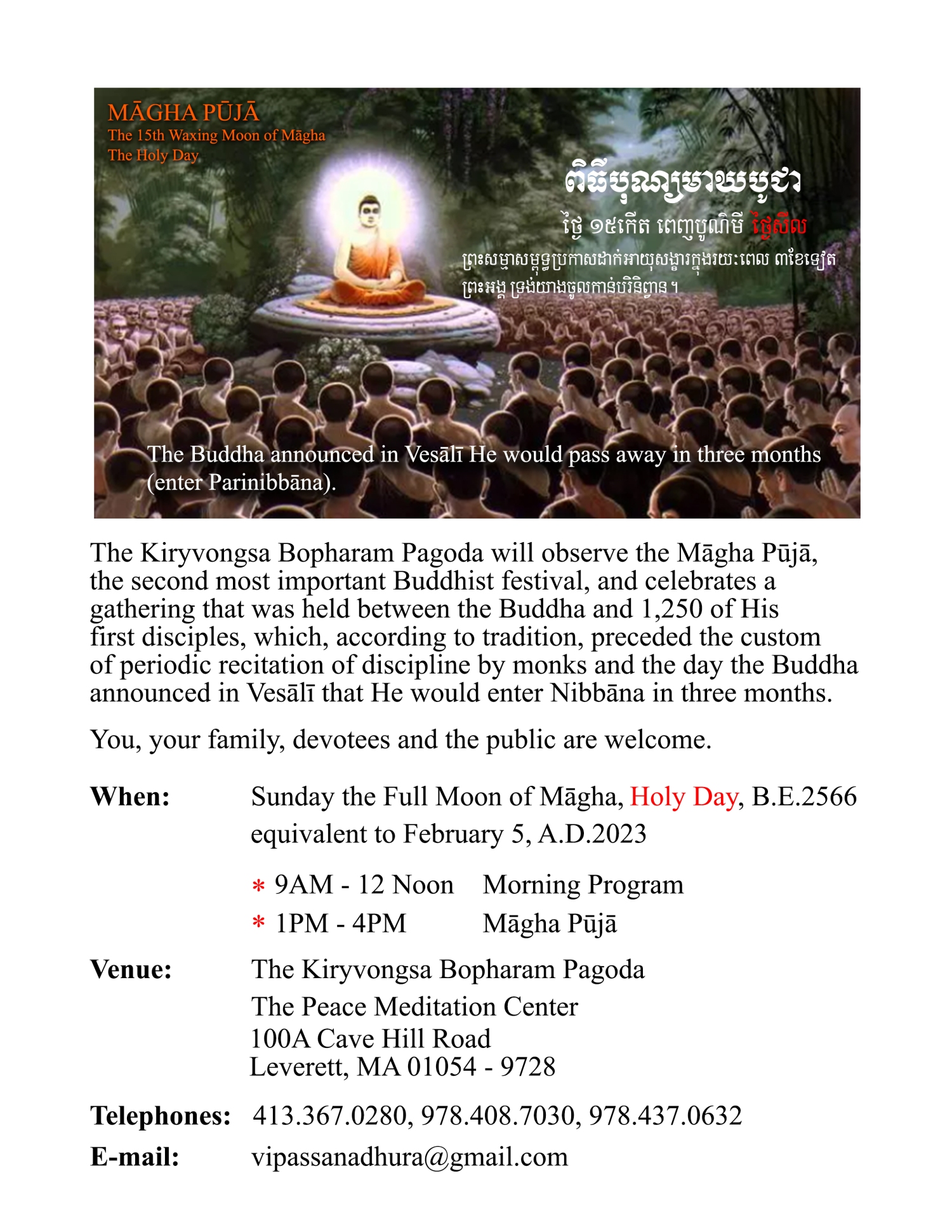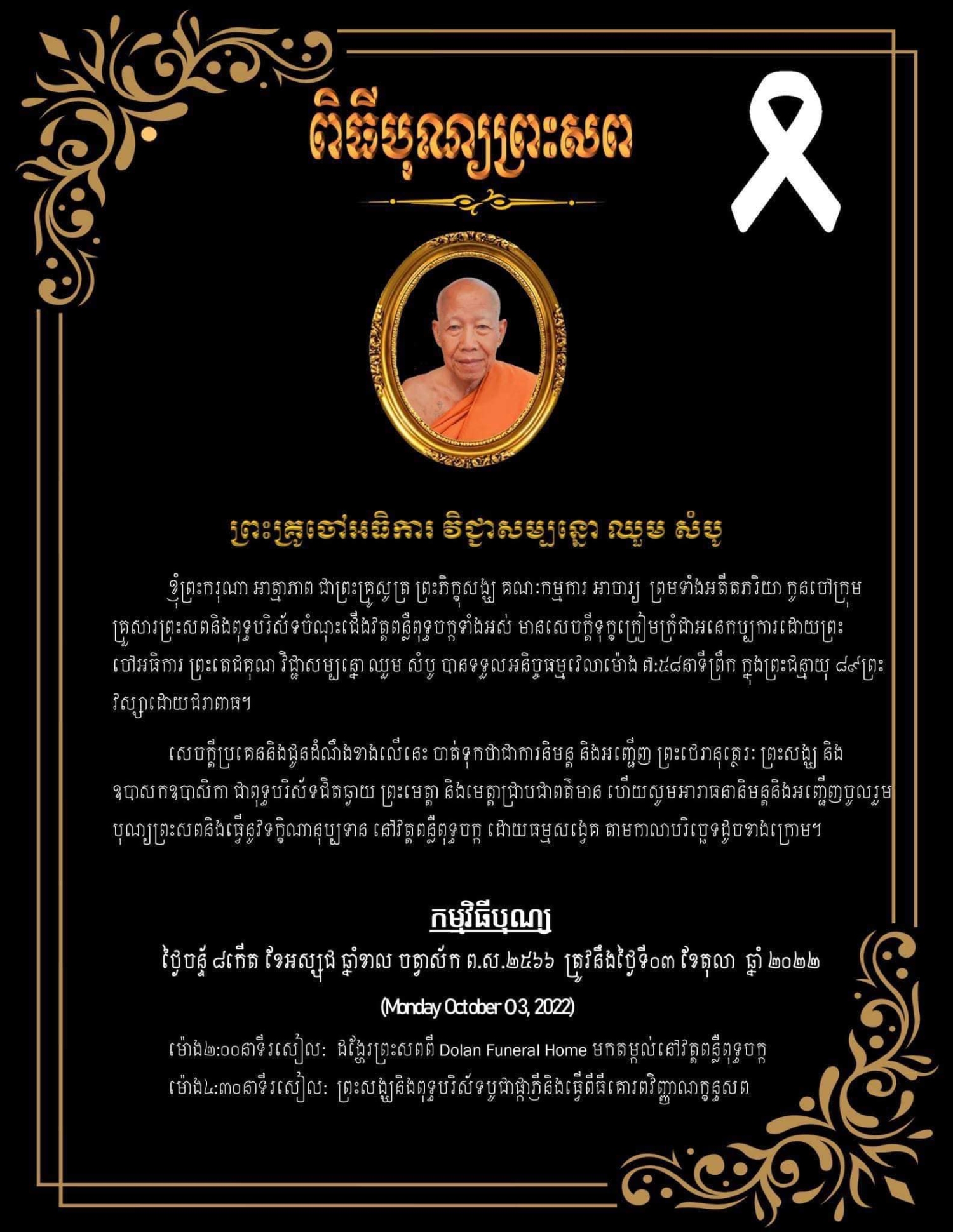Fundraising Ceremony at the Kiryvongsa Bopharam Pagoda on AUG 12 – 13, 2567/2023
ពិធីបុណ្យផ្កាប្រាក់ នៅវត្ដគិរីវង្សាបុប្ផារាម អាស្រមសមាធិសន្ដិភាព ប្រារព្ធនាថ្ងៃសៅរ៍ – អាទិត្យ ១១ – ១២រោច ខែទុតិយាសាឍ ឆ្នាំថោះ បញ្ចវាស័ក ព.ស.២៥៦៧ ត្រូវនឹងថ្ងៃទី១២ – ១៣ ខែសីហា គ.ស.២០២៣
Fundraising Ceremony to be held at the Kiryvongsa Bopharam Pagoda, the Peace Meditation Center on the 11th-12th Waning Moon of Āsāḷha, year of the Rabbit, Buddhist Era 2567 equivalent to August 12 – 13, A.D.20223
ផ្សាយនៅថ្ងៃអង្គារ ១១កើត ខែជេស្ឋ ឆ្នាំថោះ បញ្ចស័ក ព.ស.២៥៦៧ ត្រូវនឹងថ្ងៃទី៣០ ខែឧសភា គ.ស.២០២៣
Posted on Tuesday the 11th Waxing Moon of Jeṭṭha B.E.2567 equivalent to May 30, A.D.2023 Year of the Rabbit
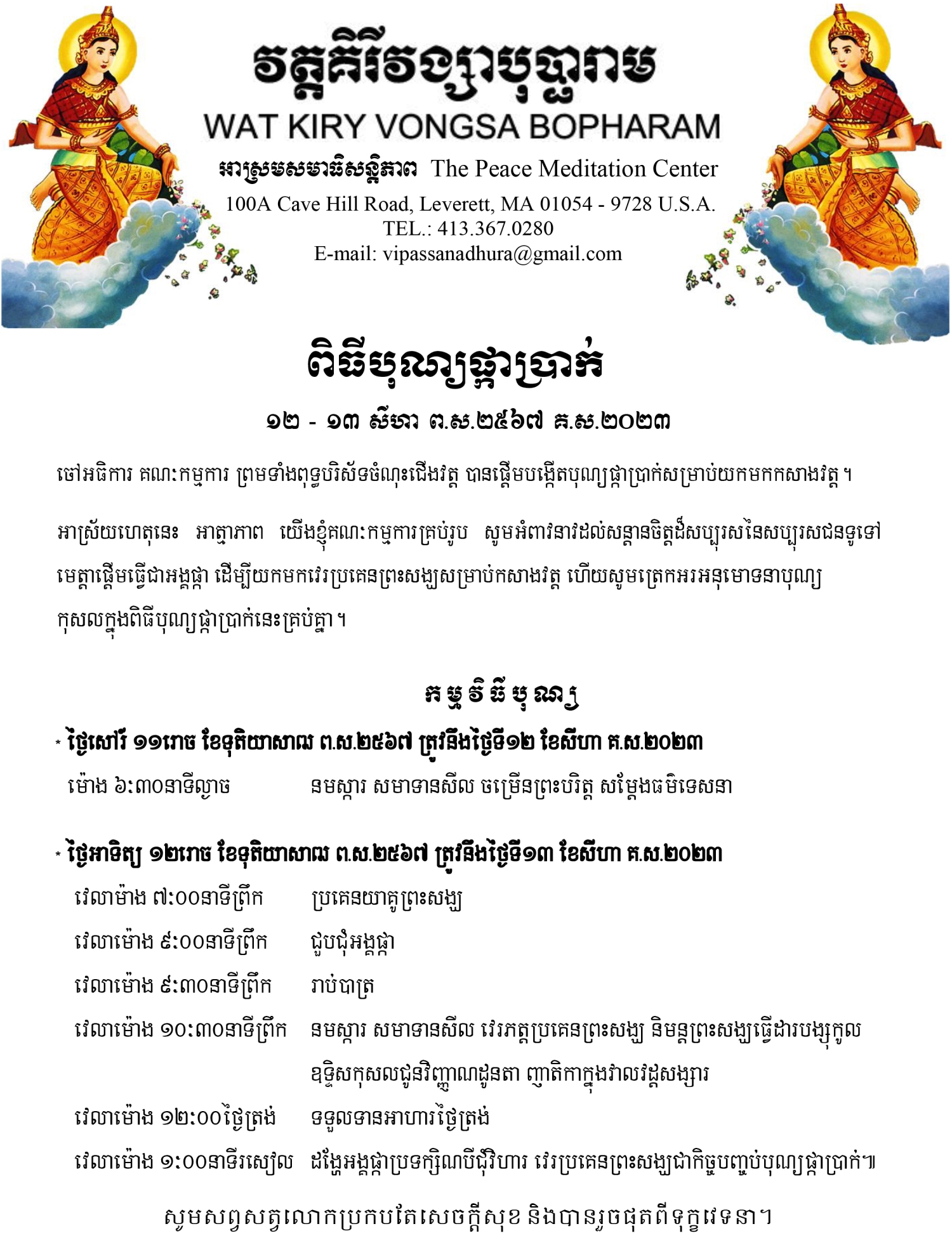
Visakha Puja at Wat Kiryvongsa Bopharam, the Peace Meditation Center on May 4
The Kiryvongsa Bopharam Pagoda celebrating New Year on April 14 – 16
Memorial Service for Bhikkhu Ketodhammo and Meditation Instructors
ពិធីបុណ្យទក្ខិណានុប្បទានព្រះធម្មវិបស្សនា កេតុធម្មោ គ្រូសមាធិកនិងវិបស្សនាកម្មដ្ឋាន ព្រមទាំងគ្រូសមាធិកម្មដ្ឋានដទៃទៀត បានប្រារព្ធនៅ
ភ្នំអដ្ឋរស ប្រទេសកម្ពុជា នៅថ្ងៃព្រហស្បតិ៍ ៥កើត ខែមាឃ ឆ្នាំខាល ចត្វាស័ក ព.ស.២៥៦៦ ត្រូវនឹងថ្ងៃទី២៦ ខែមករា គ.ស.២០២៣
Memorial Service for the late Bhikkhu Ketodhammo, renowned and revered Meditation and Vipassana Instructor, included other Meditation Instructors held at the Vipassana Center in Cambodia on Thursday the 5th Waxing Moon of Māgha B.E.2566 equivalent to January 26, A.D.2023 Year of the Tiger
ថ្ងៃព្រហស្បតិ៍ ៥កើត ខែមាឃ ឆ្នាំខាល ចត្វាស័ក ព.ស.២៥៦៦ ត្រូវនឹងថ្ងៃទី២៦ ខែមករា គ.ស.២០២៣
Thursday the 5th Waxing Moon of Māgha B.E.2566 equivalent to January 26, A.D.2023 Year of the Tiger
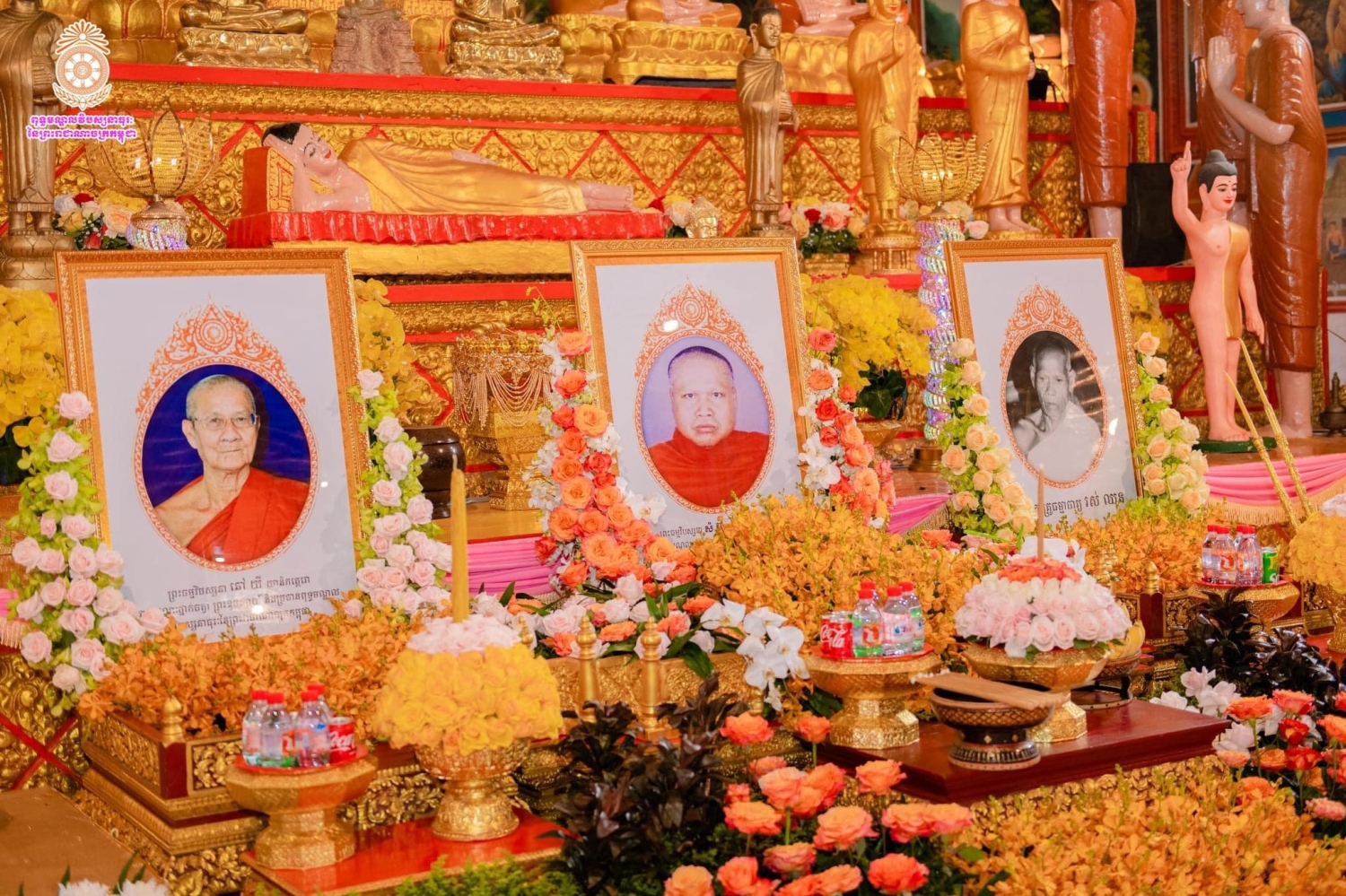
A 10-Day Meditation Retreats in Leverett, Massachusetts
រៀនធ្វើសមាធិ វិបស្សនា និងអប់រំចិត្ត
INTERESTED IN LEARNING MEDITATION
A 10-Day Meditation (Samadhi) & Vipassana (Insight Meditation) Retreats
ថ្ងៃអាទិត្យ ៩រោច ខែបុស្ស ឆ្នាំខាល ចត្វាស័ក ព.ស.២៥៦៦ ត្រូវនឹងថ្ងៃទី១៥ ខែមករា គ.ស.២០២៣
Sunday the 9th Waning Moon of Phussa B.E.2566 equivlaent to January 15, A.D.2023 Year of the Tiger
When: JUN 21 – JUL 02, B.E.2567 A.D.2023
Location: The Kiryvongsa Bopharam Pagoda, the Peace Meditation Center, Leverett, Massachusetts United States
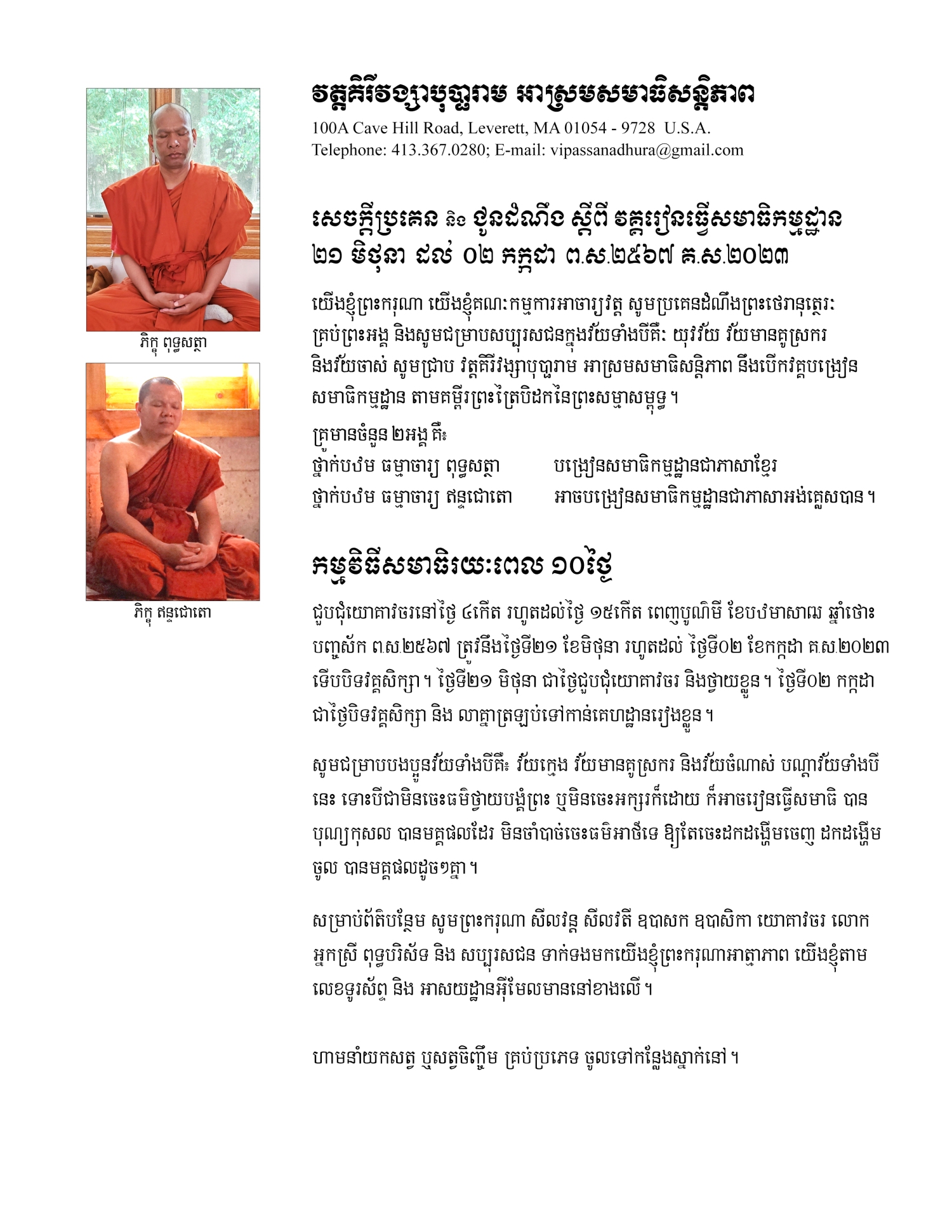
Vipassana and meditation teachers are: Bhikkhu Buddhasaddha, Bhikkhu Indajoto.
The meditation technique is taught strictly in accordance to the Buddhist Tipitaka (The Buddhist Canon).
To learn more about previous year’s program. Click on hyperlink.
Modes of Transportation
By Air: You are suggested to stop at Bradley International Airport in Connecticut. It is a 1-hour drive to the temple.
By Land: You are suggested to stop in Amherst bus station if you arrive by bus from out of state or Canada. It is about a 25-minute drive to the temple.
Please DOWNLOAD PROGRAM and REGISTRATION FORM. Complete the registration form and send it back as soon as possible.
Download Khmer PDF: Registration
Download English PDF: RegistrationEN
Contact Info:
The Kiryvongsa Bopharam Pagoda, the Peace Meditation Center
100A Cave Hill Road, Leverett, MA 01054 – 9728 U.S.A.
Tel.: 413.367.0280
Advance ENROLLMENT opens
Māgha Pūjā at Wat Kiryvongsa Bopharam on FEB 5, 2566/2023
វត្ដគិរីវង្សាបុប្ផារាម អាស្រមសមាធិសន្ដិភាព នឹងប្រារព្ធពិធីបុណ្យមាឃបូជា នៅថ្ងៃអាទិត្យ ១៥កើត ពេញបូណ៌មី ថ្ងៃសីល ឆ្នាំខាល ចត្វាស័ក ព.ស.២៥៦៦ ត្រូវនឹងថ្ងៃទី៥ ខែកុម្ភៈ គ.ស.២០២៣
The Kiryvongsa Bopharam Pagoda, the Peace Meditation Center to observe the Māgha Pūjā on Sunday the 15th Waxing Moon of Māgha, Day of Abstinence, B.E.2566 equivalent to February 5, A.D.2023.
Venue: The Kiryvongsa Bopharam Pagoda, the Peace Meditation Center
100A Cave Hill Road, Leverett, MA 01054 – 9728
Tel.: 413.367.0280, 978.408.7030, 978.437.0632
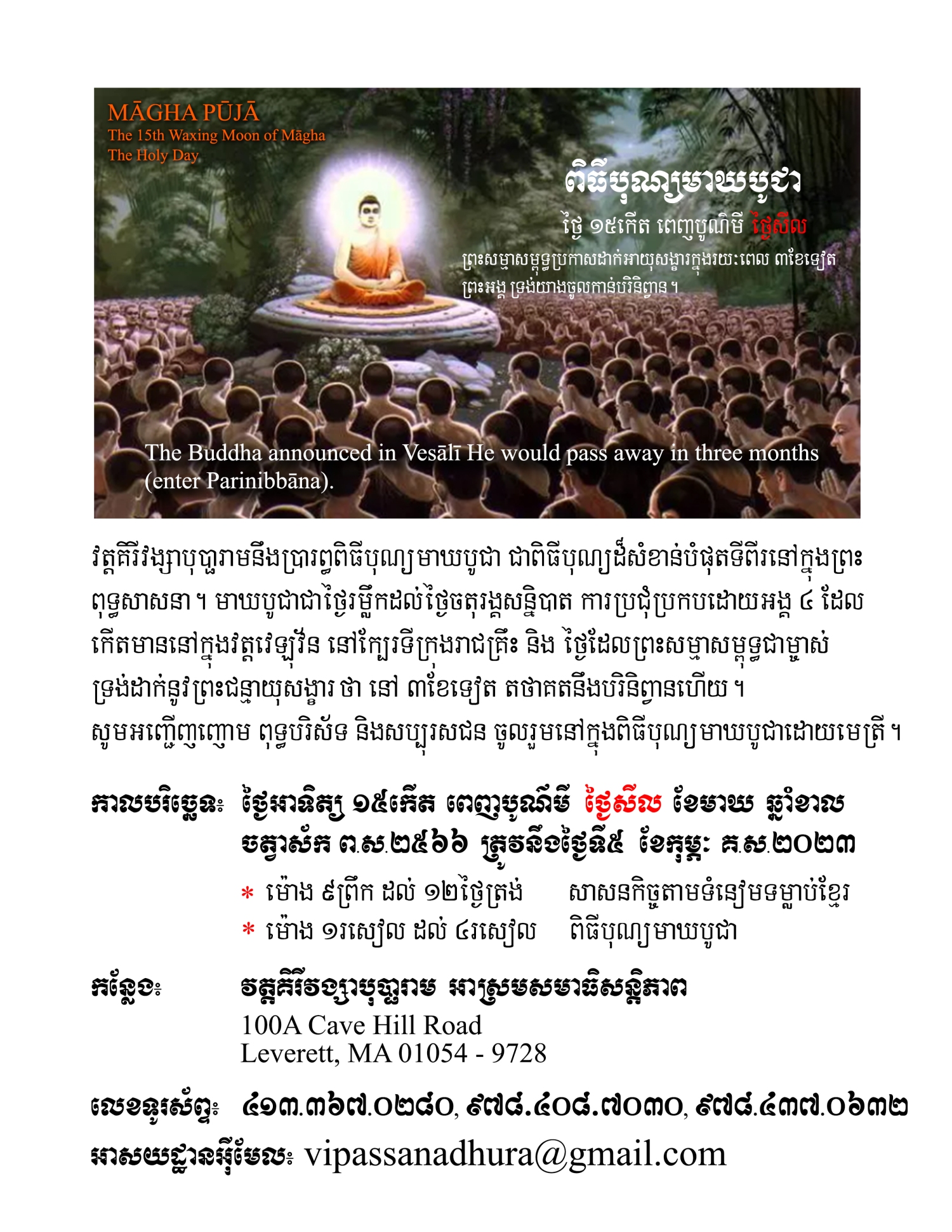
Background on មាឃបូជា Māgha Pūjā
Māgha Pūjā is the second most important Buddhist festival, celebrated on the full moon day of the third lunar month in Cambodia, Laos, Thailand, Sri Lanka and on the full moon day of Tabaung in Myanmar. It celebrates a gathering that was held between the Buddha and 1,250 of his first disciples, which, according to tradition, preceded the custom of periodic recitation of discipline by monks. On the day, Buddhists celebrate the creation of an ideal and exemplary community, which is why it is sometimes called Saṅgha Day, the Saṅgha referring to the Buddhist community, and for some Buddhist schools this is specifically the monastic community. In Thailand, the Pāli term Māgha-pūraṇamī is also used for the celebration, meaning ‘to honor on the full moon of the third lunar month’. Finally, some authors have also referred to the day as the Buddhist All Saints Day.
Celebration of Māgha Pūjā is a public holiday in many Southeast Asian countries and is an occasion when Buddhists go to the temple to perform merit-making activities, such as alms giving, meditation and listening to teachings. It has been proposed as a more spiritual alternative to the celebration of Valentine’s Day.
Māgha is derived from the name of the third month in the traditional Indian lunar calendar, on which the celebration is held. It is also the name of a star, which during this period is close to the full moon. Māgha Pūjā is held on the full moon day. In a leap year, the celebration will be postponed to the full moon day of the fourth lunar month.
Māgha Pūjā day marks an event occurring at the Veḷuvana grove, near Rājagaha (present Rajgir) in northern India, ten months after the enlightenment of the Buddha. The traditional story goes that a meeting is held in the afternoon, that has four characteristics:
1,250 disciples come to see the Buddha that evening without being summoned; These are mostly pupils from the Buddha’s recently converted disciples, such as the three Kassapa brothers, and the monks Sāriputta and Mogallāna.
All of them are Arahants, enlightened disciples;
All have been ordained by the Buddha himself, and therefore are his direct spiritual descendants;
It is the full-moon day of the third lunar month.
Because of these four factors, Māgha Pūjā is also known as the Fourfold Assembly Day. On this occasion, the Buddha teaches those arahants a summary of Buddhism, called the Ovādapatimokkha. In these, three principles are given:
“The non-doing of evil / the full performance of what is wholesome / the total purification of the mind.”
This is followed by a formulation of Buddhist ideals:
“Patience (and) forbearance are the highest austerity. The awakened ones say nibbāna is the highest. One is certainly not a wanderer if one injures others; one is not an ascetic if one harms another.”
Finally, the last stanza is about the path of religious practice:
“Not abusing, not injuring, and restraint under the rules of discipline, and knowing moderation in eating, and secluded lodgings, and exertion in respect of higher thought, this is the teaching of the awakened ones.”
According to the traditional Pāli commentaries, the Buddha continued to teach this summary for a period of twenty years, after which the custom was replaced by the recitation of the monastic code of discipline by the Saṅgha themselves. On Māgha Pūjā, Buddhists celebrate the creation of an ideal and exemplary community.
Māgha Pūjā is also the day that the Buddha is believed to have announced in Vesālī he would die in three months, after which a miraculous earthquake followed. Moreover, in Sri Lanka, it is considered the day that the Buddha appointed his two main disciples, the monks Sāriputta and Moggallāna. Apart from the religious meaning, Māgha Pūjā also reflects the Southeast Asian agricultural year, as it is celebrated after the harvest.
It is unknown how traditional Buddhist societies celebrated this event in pre-modern times, but in Thailand, the first known instance was during the reign of the Thai king Rama IV (1804–68), who instituted it. He first held it in the palace only. In the evening, 31 monks would recite the Ovādapatimokkha, lit lanterns around the ubosot (ordination hall), and give a sermon about the same Ovādapatimokkha. A recitation text used for this occasion is attributed to Rama IV. Rama IV’s successor Rama V (A.D.1853 – A.D.1910) expanded the practice and organized it as a national celebration in the Temple of the Emerald Buddha. From Thailand, the practice spread to neighboring countries. Already in A.D. 1937, the ceremony was widely held and observed in Thailand.
Māgha Pūjā is a day that laypeople make merit. Monastics and devotees will hold processions, light candles, and make offerings. Māgha Pūjā is celebrated most extensively in Cambodia and Thailand, but it is a national holiday in most Southeast Asian countries, such as Laos, Myanmar and Cambodia.
In Thailand, Māgha Pūjā was instituted by Rama IV. It is currently designated as a national holiday, on which sale of alcohol is strictly prohibited. On the evening of Māgha Pūjā, most temples in Thailand hold a candlelight procession. Furthermore, people will make merit by going to temples and by joining in with activities, such as listening to teachings, giving alms, etc. At times, special events are also held, such as a recital of the entire Buddhist scriptures and ceremonies for avowing oneself as a Buddhist lay person. In A.D.2006, the government of Thailand made an announcement that Māgha Pūjā should be celebrated as a “national day of gratitude.” Māgha Pūja was therefore presented as a day of spiritual love and gratitude instead.
In Sri Lanka and Cambodia, Māgha Pūjā is also observed. In Chinese communities, as well as in Myanmar, a similar festival as Māgha Pūjā is observed. The Burmese people celebrate this on the full moon of the month Tabaung according to their traditional calendar. Fifteen days before this full moon day, a Shwedagon Pagoda Festival is held, on which a ceremony is held for offerings to the 28 Buddhas (from Taṇhaṅkara to Gotama Buddha), followed by a 10-day, continuous recital of Buddhist texts. Burmese devotees make merits and meditate during this period.
Māgha Pūjā has also become a popular event among Western Buddhist converts in the West. Wikipedia
ផ្សាយនៅថ្ងៃអាទិត្យ ២រោច ខែបុស្ស ឆ្នាំខាល ចត្វាស័ក ព.ស.២៥៦៦ ត្រូវនឹងថ្ងៃទី៨ ខែមករា គ.ស.២០២៣
Sunday the 2nd Waning Moon of Phussa B.E.2566 equivalent to January 8, A.D.2023 Year of the Tiger
Kathin at Wat Sanghikaram on OCT 22 – 23
ពិធីបុណ្យកឋិន នៅវត្ដសង្ឃិការាម ទីក្រុងលីន រដ្ឋម៉ាសាឈូសិត្ដស៍ ថ្ងៃទី២២ - ២៣ ខែតុលា ព.ស.២៥៦៦ គ.ស.២០២២
Kathin at the Sanghikaram Pagoda in Lynn, Massachusetts on OCT 22 - 23, B.E.2566 A.D.2022
ថ្ងៃអាទិត្យ ៦រោច ខែអស្សុជ ឆ្នាំខាល ចត្វាស័ក ព.ស.២៥៦៦ ត្រូវនឹងថ្ងៃទី១៦ ខែតុលា គ.ស.២០២២
Sunday 6th Waning Moon of Assayuja B.E.2566 equivalent to October 16, A.D.2022 Year of the Tiger
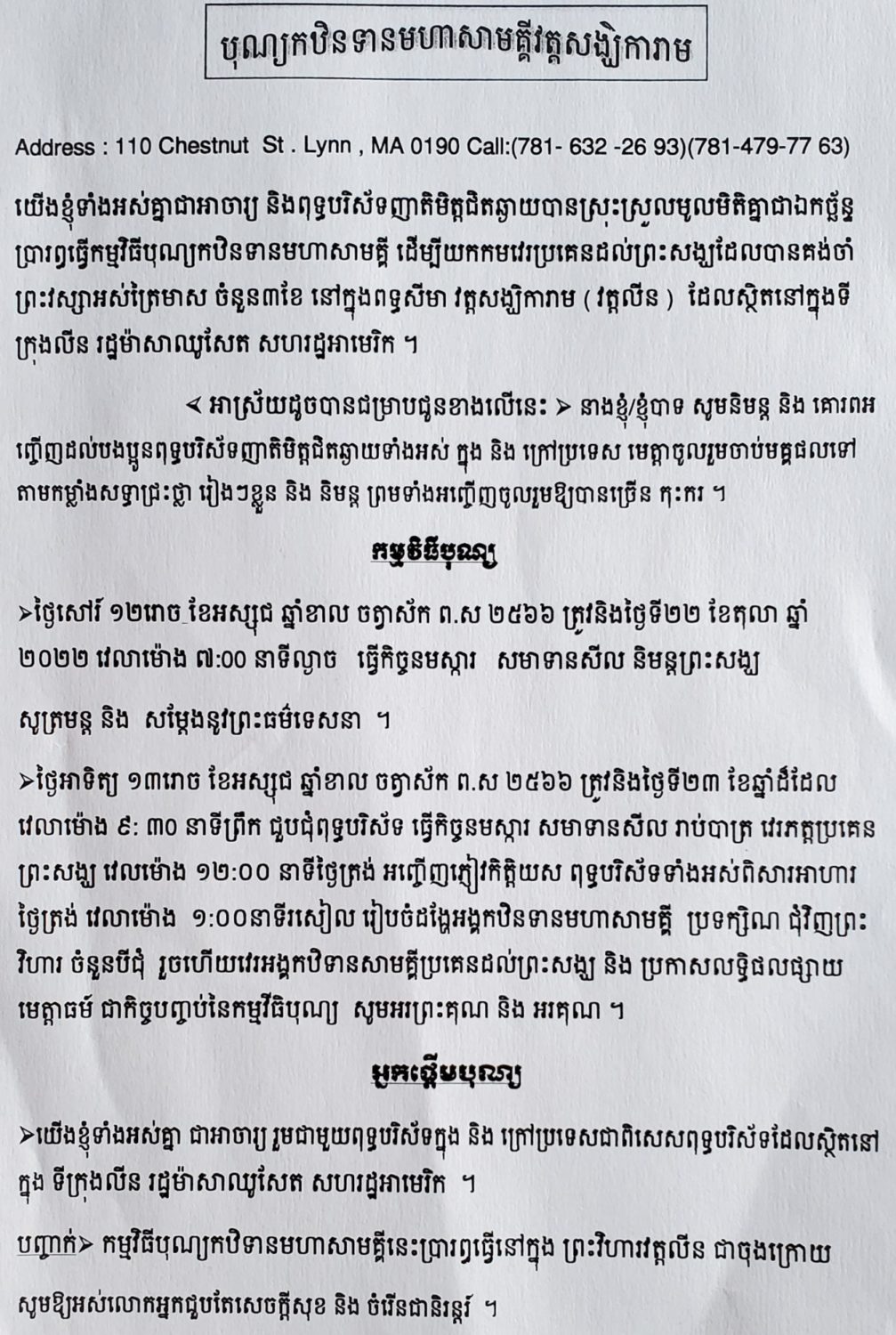
ពាក្យមួយចំនួនត្រូវបានកែ៖ អញ្ជើញ, ត្រូវនឹង, ដដែល, ពិសា, លទ្ធផល, ធម៌, កម្មវិធី, បញ្ជាក់, ចម្រើន៕
Kathin at IKBM Pagoda on OCT 15 – 16
ពិធីបុណ្យកឋិន នៅមជ្ឈមណ្ឌលសហគមន៍ព្រះសង្ឃខ្មែរអន្ដរជាតិ ថ្ងៃទី១៥ - ១៦ ខែតុលា ព.ស.២៥៦៦ គ.ស.២០២២
Kathin at the International Community of Khmer Buddhist Monks Center on OCT 15 - 16, B.E.2566 A.D.2022
ថ្ងៃអាទិត្យ ១៥កើត ថ្ងៃសីល ខែអស្សុជ ឆ្នាំខាល ចត្វាស័ក ព.ស.២៥៦៦ ត្រូវនឹងថ្ងៃទី១០ ខែតុលា គ.ស.២០២២
Monday 15th Waxing Moon, Holy Day, of Assayuja B.E.2566 equivalent to October 10, A.D.2022 Year of the Tiger
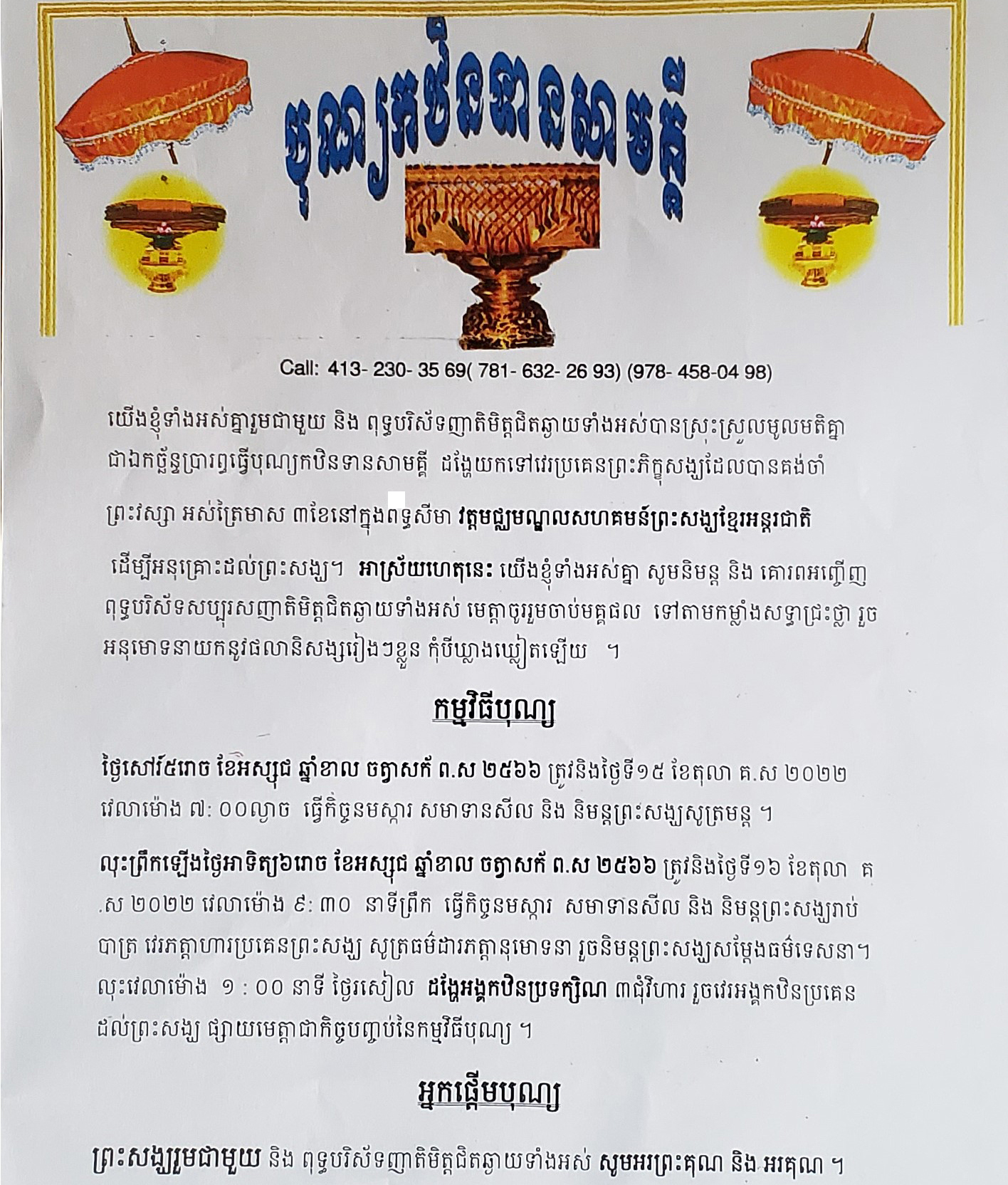 កែពទ្ធសីមា
កែពទ្ធសីមា
កែអញ្ជើញ
កែត្រូវនឹង
Kathin at Kiryvongsa Bopharam Pagoda on NOV 5 – 6
ពិធីបុណ្យកឋិន នៅវត្ដគិរីវង្សាបុប្ផារាម ថ្ងៃទី៥ - ៦ ខែវិច្ឆិកា ព.ស.២៥៦៦ គ.ស.២០២២
Kathin at Kiryvongsa Bopharam Pagoda on NOV 5 - 6, B.E.2566 A.D.2022
ថ្ងៃពុធ ១២រោច ខែស្រាពណ៍ ឆ្នាំខាល ចត្វាស័ក ព.ស.២៥៦៦ ត្រូវនឹងថ្ងៃទី២៤ ខែសីហា គ.ស.២០២២
Wednesday the 12th Waning Moon of Sāvaṇa B.E.2566 equivalent to August 24, A.D.2022 Year of the Tiger
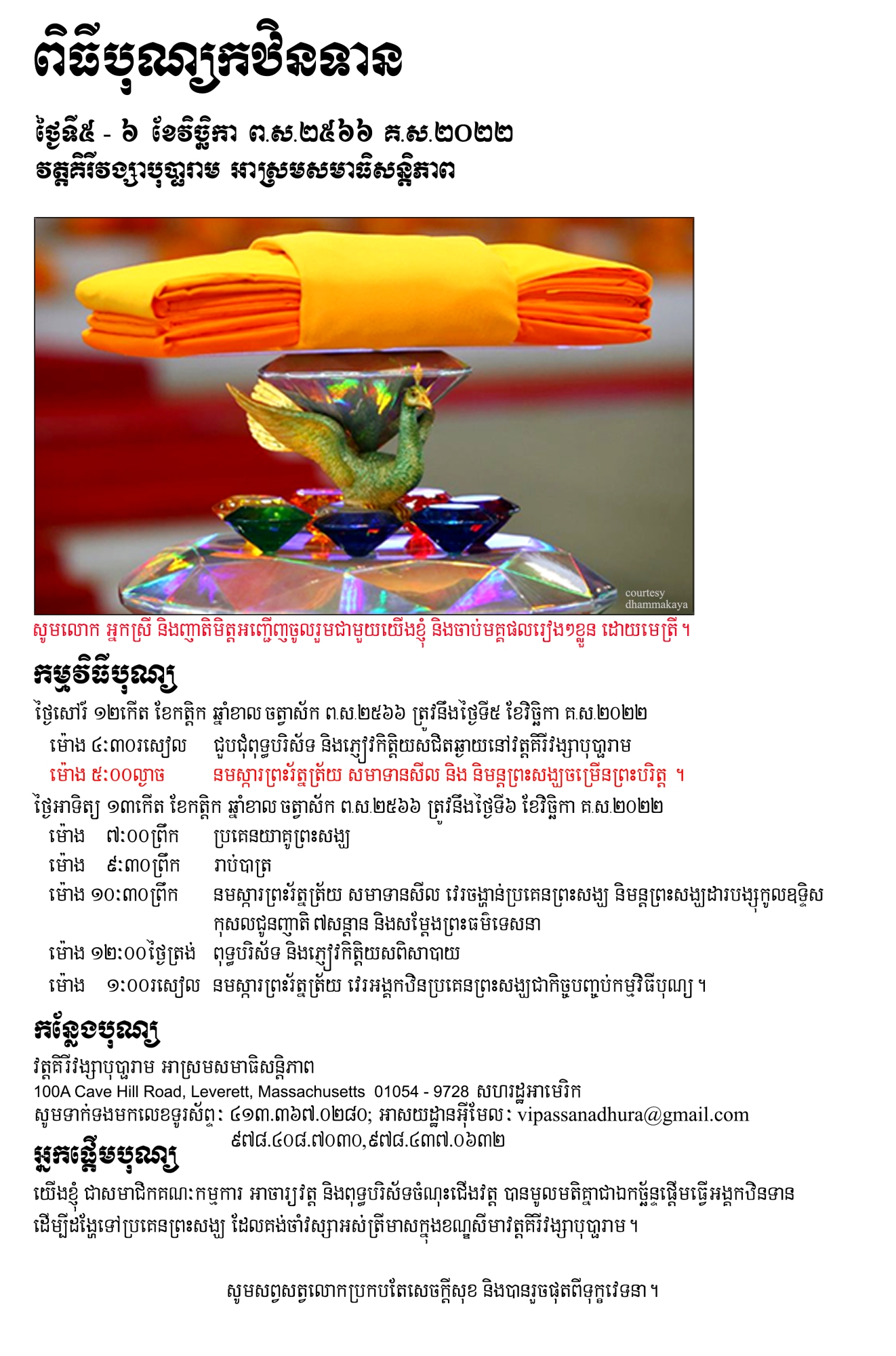
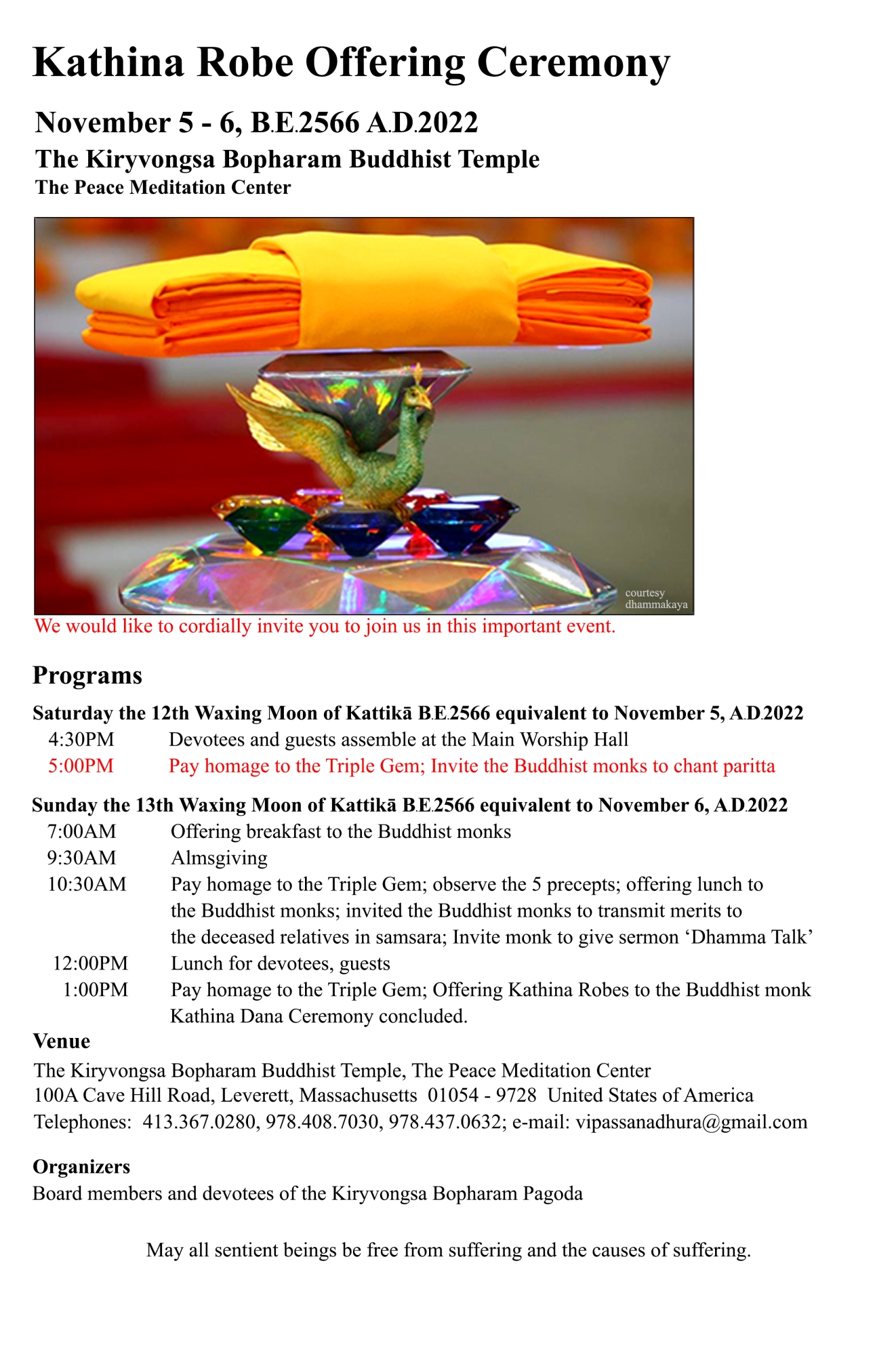
Wat KB celebrating Ancestors Memorial Festivity on SEP 11 – 25
ពិធីបុណ្យកាន់បិណ្ឌ និងពិធីបុណ្យភ្ជុំបិណ្ឌ នឹងប្រារព្ធនៅថ្ងៃ ១រោច ដល់ថ្ងៃ ៣កើត ខែអស្សុជ ព.ស.២៥៦៦ ត្រូវនឹងថ្ងៃទី១១ ដល់ថ្ងៃទី២៥ ខែកញ្ញា គ.ស.២០២២
ថ្ងៃចន្ទ ៣រោច ខែស្រាពណ៍ ឆ្នាំខាល ចត្វាស័ក ព.ស.២៥៦៦ ត្រូវនឹងថ្ងៃទី១៥ ខែសីហា គ.ស.២០២២
Monday the 3rd Waning Moon of Sāvaṇa B.E.2566 equivalent to August 15, A.D.2022 Year of the Tiger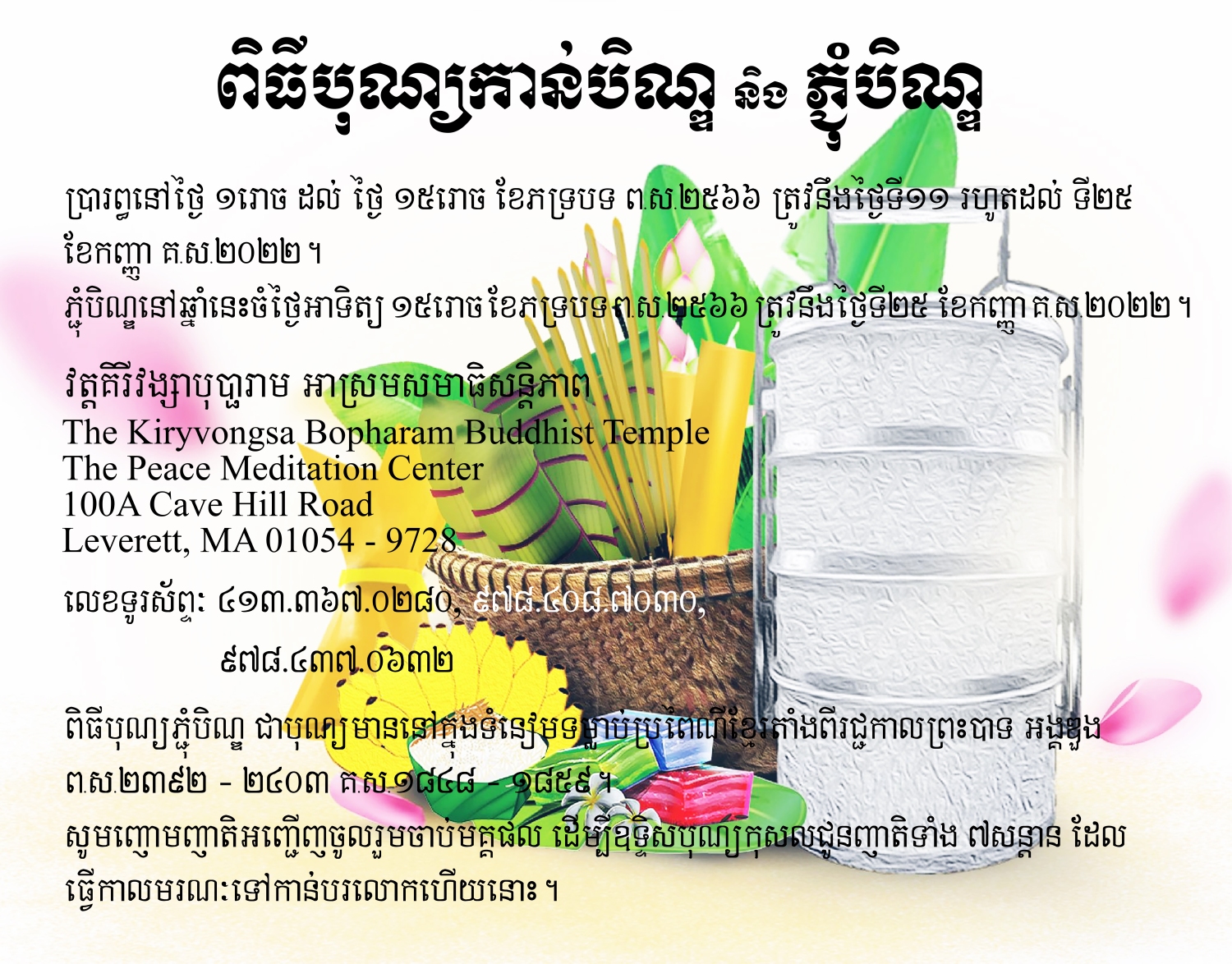
វត្ដគិរីវង្សាបុប្ផារាម អាស្រមសមាធិសន្ដិភាព
The Kiryvongsa Bopharam Buddhist Temple celebrating Ancestors Memorial Festivity on SEP 2 – 19
The Peace Meditation Center
100A Cave Hill Road
Leverett, MA 01054 – 9728
លេខទូរស័ព្ទ៖ ៤១៣.៣៦៧.០២៨០, ៩៧៨.៤០៨.៧០៣០, ៩៧៨.៤៣៧.០៦៣២
Telephones: 413.367.0280, 978.408.7030, 978.437.0632
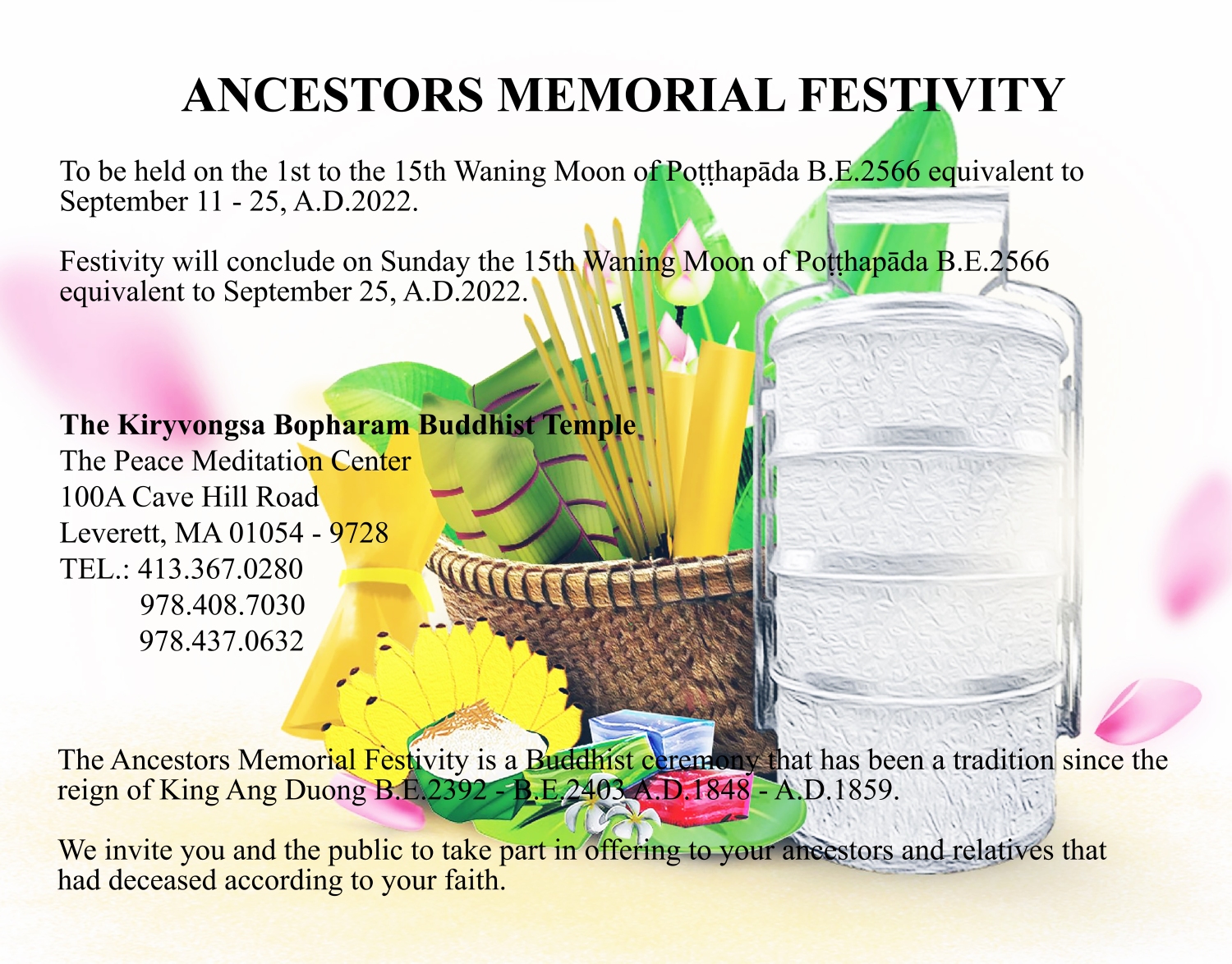
Fundraising Ceremony at the Kiryvongsa Bopharam Pagoda, the Peace Meditation on AUG 13 – 14
ពិធីបុណ្យផ្កាប្រាក់ នៅវត្ដគិរីវង្សាបុប្ផារាម អាស្រមសមាធិសន្ដិភាព ប្រារព្ធនាថ្ងៃសៅរ៍ – អាទិត្យ ១ – ២រោច ខែស្រាពណ៍ ឆ្នាំខាល ចត្វាស័ក ព.ស.២៥៦៦ ត្រូវនឹងថ្ងៃទី១៣ – ១៤ ខែសីហា គ.ស.២០២២
ថ្ងៃសុក្រ ១០កើត ខែអាសាឍ ឆ្នាំខាល ចត្វាស័ក ព.ស.២៥៦៦ ត្រូវនឹងថ្ងៃទី៨ ខែកក្កដា គ.ស.២០២២
Friday the 10th Waxing Moon of Āsāḷha B.E.2566 equivalent to July 8, A.D.2022 Year of the Tiger
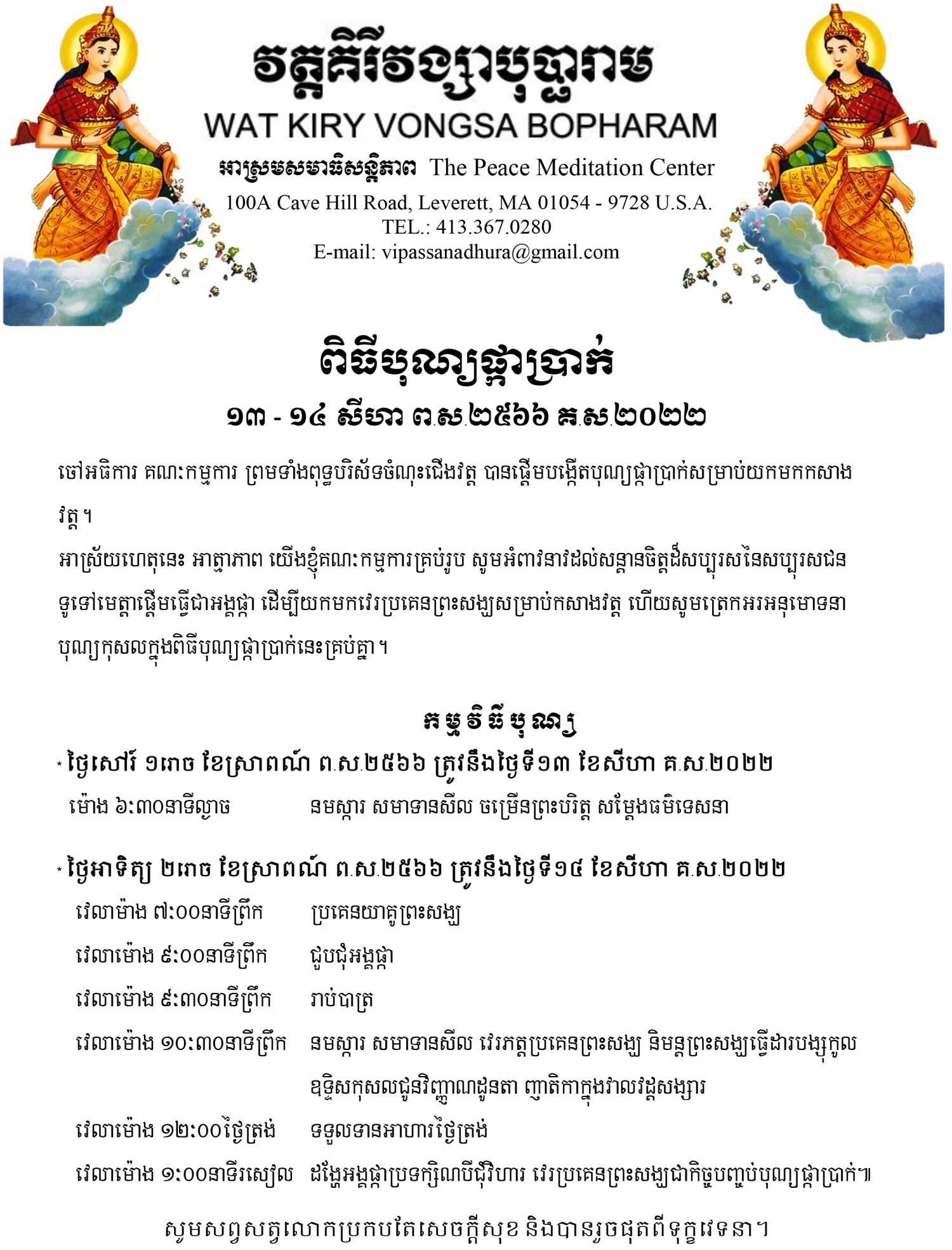
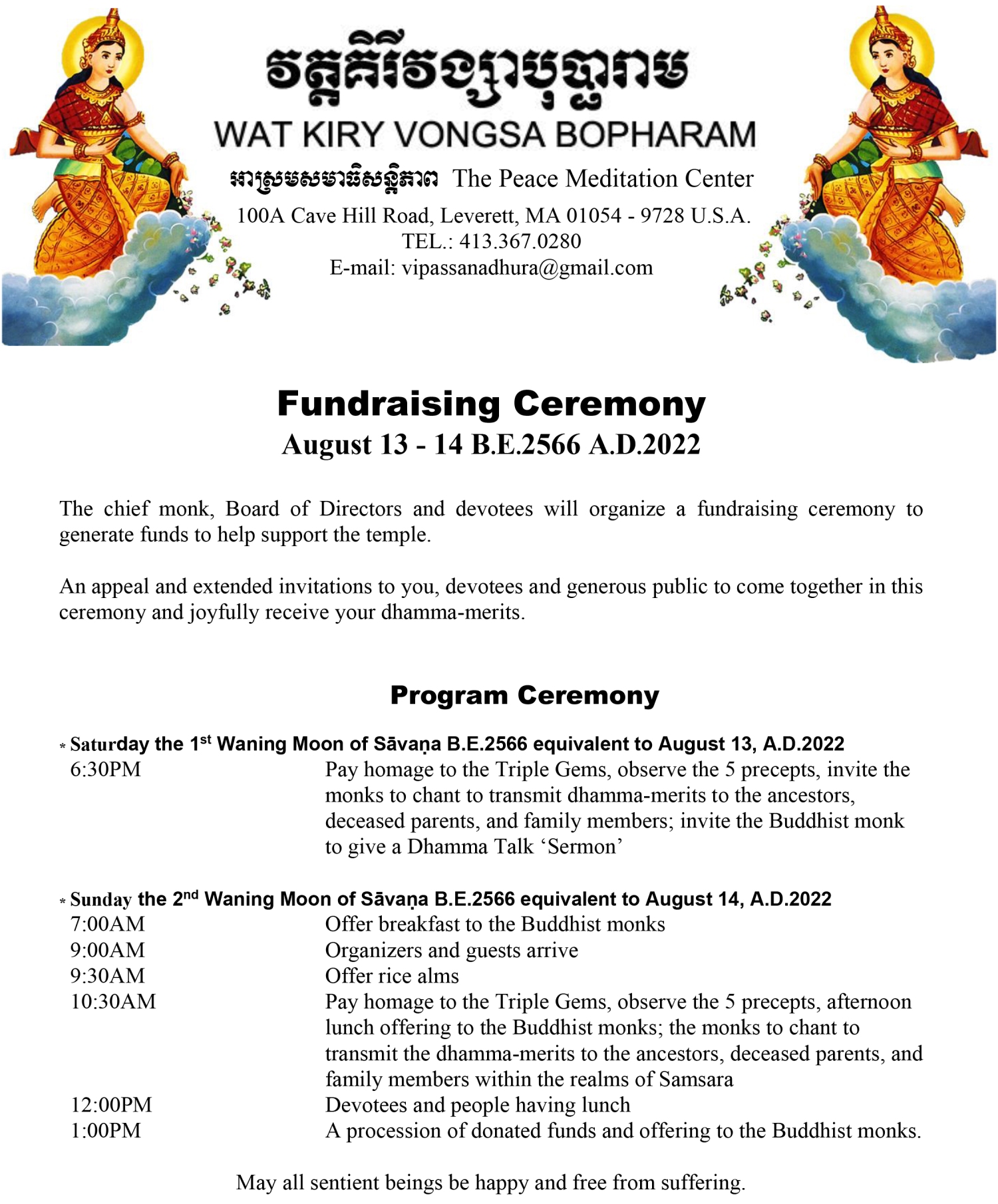
Vassa, Rains Retreat at the Kiryvongsa Bopharam, the Peace Meditation Center on July 14
ពិធីបុណ្យចូលព្រះវស្សា ប្រារព្ធនៅវត្ដគិរីវង្សាបុប្ផារាម អាស្រមសមាធិសន្ដិភាព ថ្ងៃទី១៤ ខែកក្កដា ព.ស.២៥៦៦ គ.ស.២០២២
Vassa, Rains Retreat at the Kiryvongsa Bopharam, the Peace Meditation Center on July 14, B.E.2566 A.D.2022
ថ្ងៃសុក្រ ១០កើត ខែអាសាឍ ឆ្នាំខាល ចត្វាស័ក ព.ស.២៥៦៦ ត្រូវនឹងថ្ងៃទី៨ ខែកក្កដា គ.ស.២០២២
Friday the 10th Waxing Moon of Āsāḷha B.E.2566 equivalent to July 14, A.D.2022 Year of the Tiger
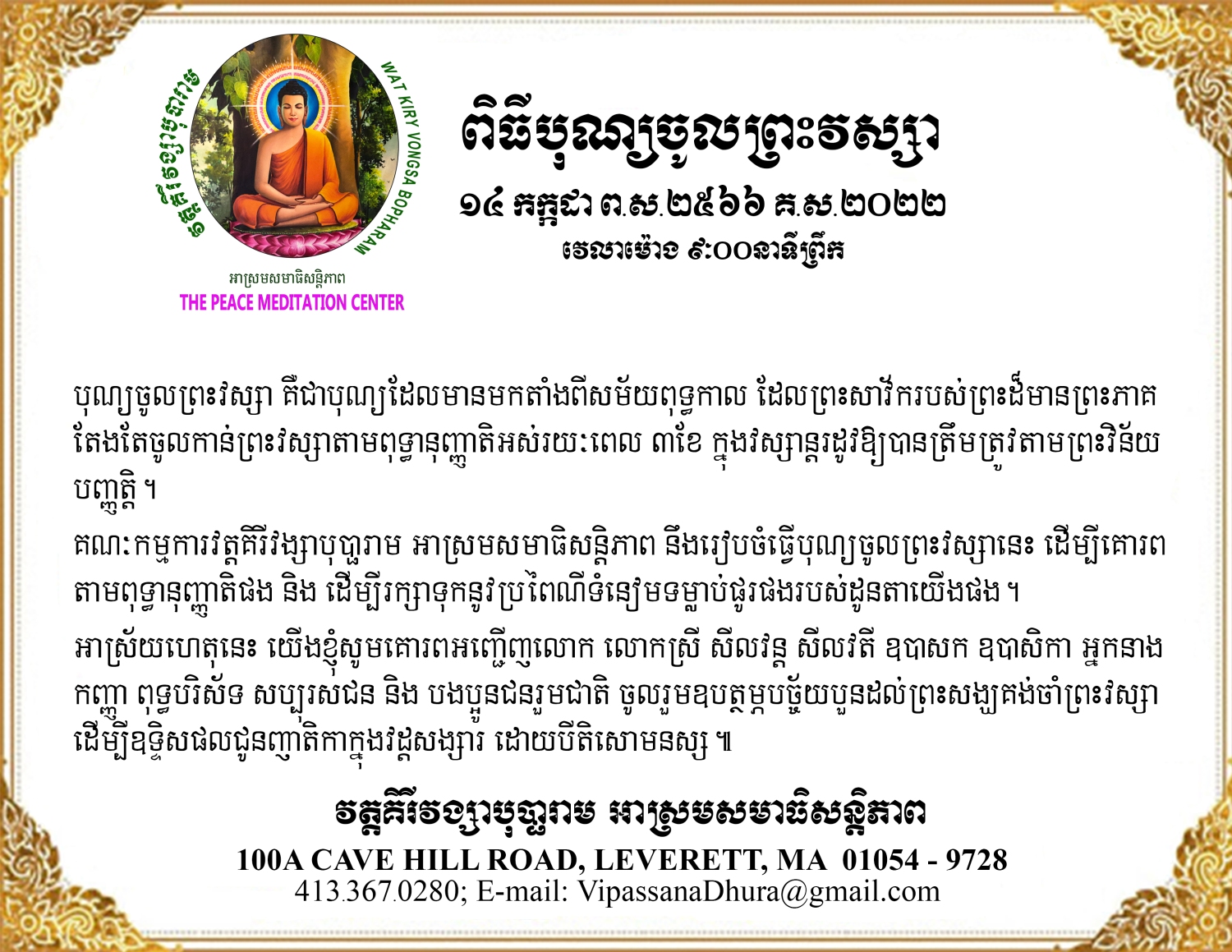
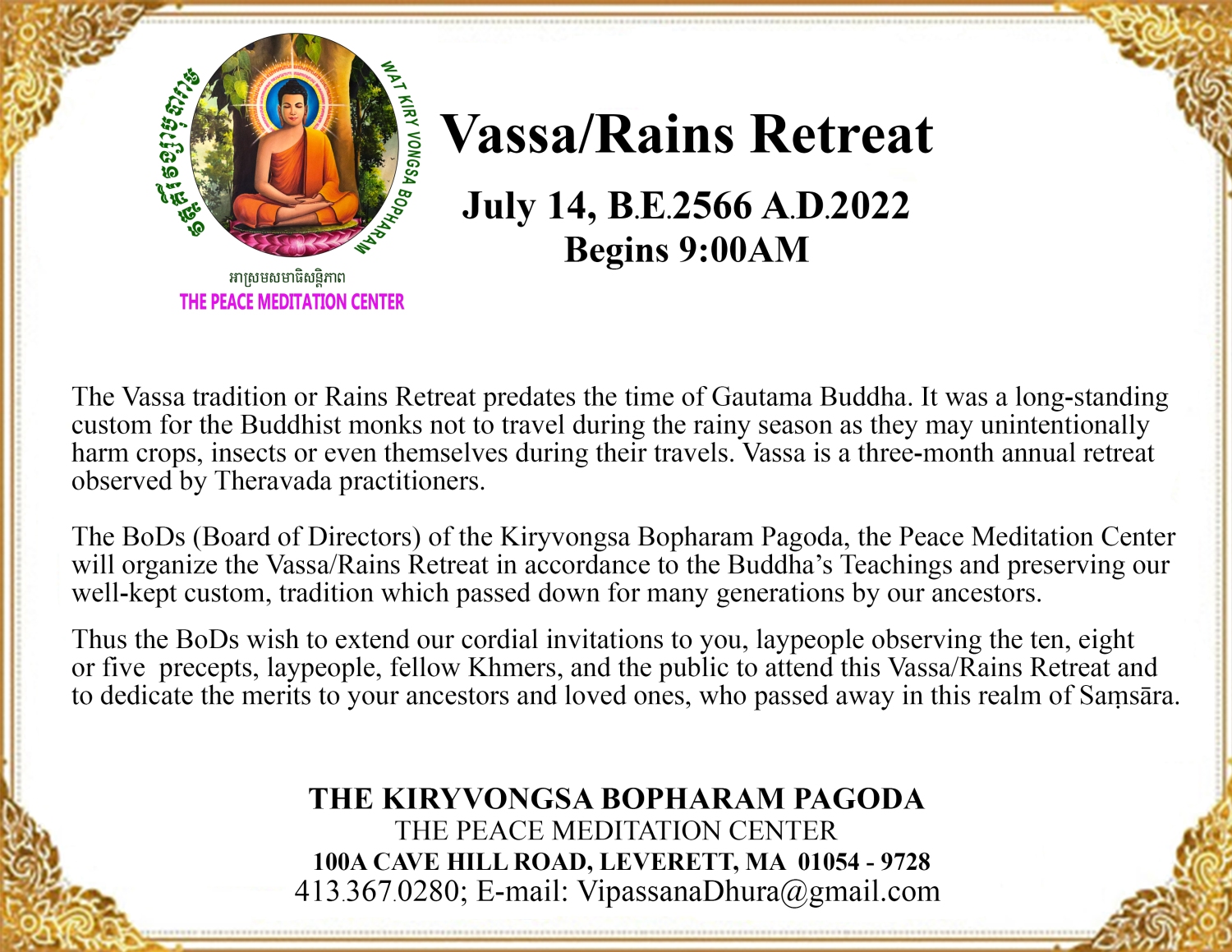
Memorial Service of Bhikkhu Dejapanno on JUL 02
ពិធីបុណ្យទក្ខិណានុប្បទានព្រះធម្មាចារ្យ តេជប្បញ្ញោ នឹងប្រារព្ធនៅថ្ងៃទី០២ ខែកក្កដា ព.ស.២៥៦៦ គ.ស.២០២២
Bhikkhu Dejapanno Memorial Services on July 2, B.E.2566 A.D.2022
ថ្ងៃអាទិត្យ ១៤រោច ថ្ងៃកោរ ខែពិសាខ ឆ្នាំខាល ចត្វាស័ក ព.ស.២៥៦៦ ត្រូវនឹងថ្ងៃទី២៩ ខែឧសភា គ.ស.២០២២
Sunday the 14th Waning Moon, Head Shaving Day, of Vesākha B.E.2566 equivalent to May 29, A.D.2022 Year of the Tiger
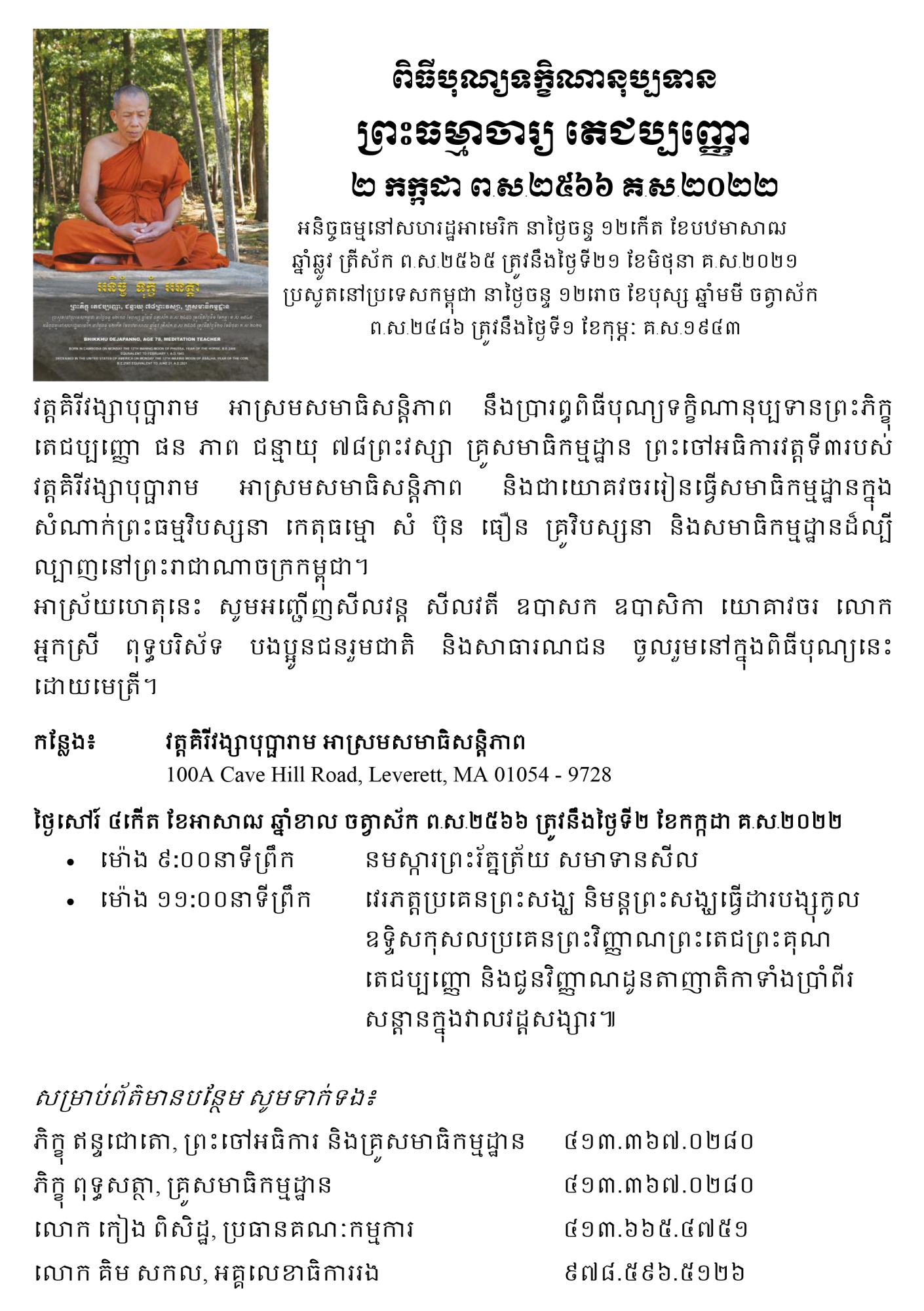
Visakha Puja to be held at Wat Kiryvongsa Bopharam, the Peace Meditation Center on May 15
ពិធីបុណ្យវិសាខបូជា នឹងប្រារព្ធនៅវត្ដគិរីវង្សាបុប្ផារាម អាស្រមសមាធិសន្ដិភាព ថ្ងៃទី១៥ ឧសភា
ថ្ងៃសៅរ៍ ១៥កើត ពេញបូណ៌មី ថ្ងៃសីល ខែចេត្រ ឆ្នាំខាល ចត្វាស័ក ព.ស.២៥៦៥ ត្រូវនឹងថ្ងៃទី១៦ ខែមេសា គ.ស.២០២២
Saturday the 15th Waxing Moon, Holy Day, of Citta B.E.2565 equivalent to April 16, A.D.2022 Year of the Tiger
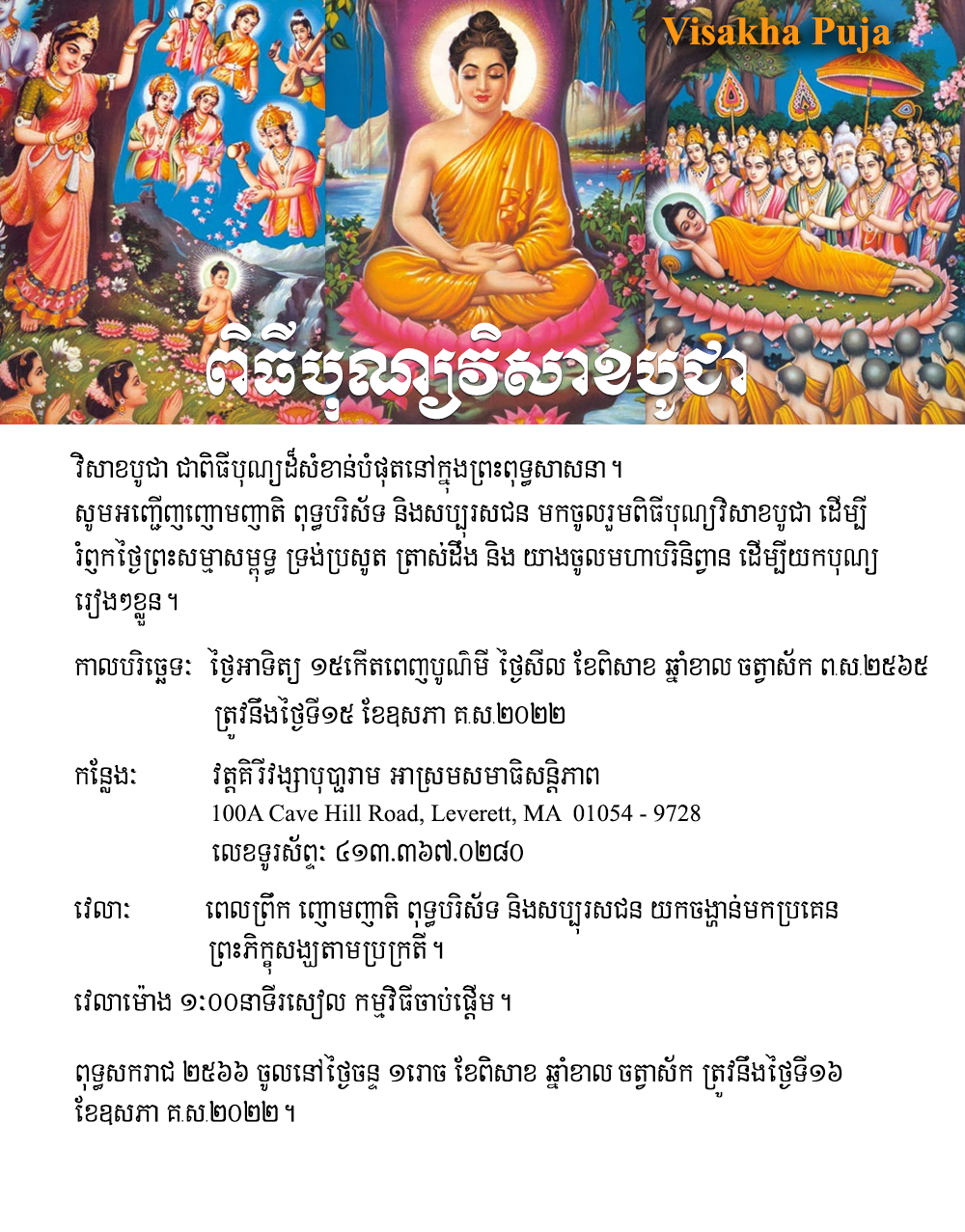 វត្ដគិរីវង្សាបុប្ផារាម អាស្រមសមាធិសន្ដិភាព នឹងប្រារព្ធពិធីបុណ្យវិសាខបូជា ដើម្បីរម្លឹកថ្ងៃព្រះសម្មាសម្ពុទ្ទ ទ្រង់ប្រសូត ត្រាស់ដឹង និងយាងចូលមហាបរិនិព្វាន នៅថ្ងៃសៅរ៍ ១៥កើតពេញបូណ៌មី ថ្ងៃសីល
វត្ដគិរីវង្សាបុប្ផារាម អាស្រមសមាធិសន្ដិភាព នឹងប្រារព្ធពិធីបុណ្យវិសាខបូជា ដើម្បីរម្លឹកថ្ងៃព្រះសម្មាសម្ពុទ្ទ ទ្រង់ប្រសូត ត្រាស់ដឹង និងយាងចូលមហាបរិនិព្វាន នៅថ្ងៃសៅរ៍ ១៥កើតពេញបូណ៌មី ថ្ងៃសីល
ខែពិសាខ ឆ្នាំខាល ចត្វាស័ក ព.ស.២៥៦៥ ត្រូវនឹងថ្ងៃទី១៥ ខែឧសភា គ.ស.២០២២ វេលាម៉ោង ១ៈ០០នាទីរសៀល។ វិសាខបូជាជាពិធីបុណ្យដ៏សំខាន់បំផុតនៅក្នុងព្រះពុទ្ធសាសនា។
The Kiryvongsa Bopharam Buddhist Temple, the Peace Meditation Center will hold Visakha Puja to commemorate the 3 auspicious events of the Buddha: His Birth, Enlightenment and Mahaparinibbana (Passing or Death). Visakha Puja is an extremely important day in the Buddhist tradition and also known as Buddha Purnima and Buddha Day.
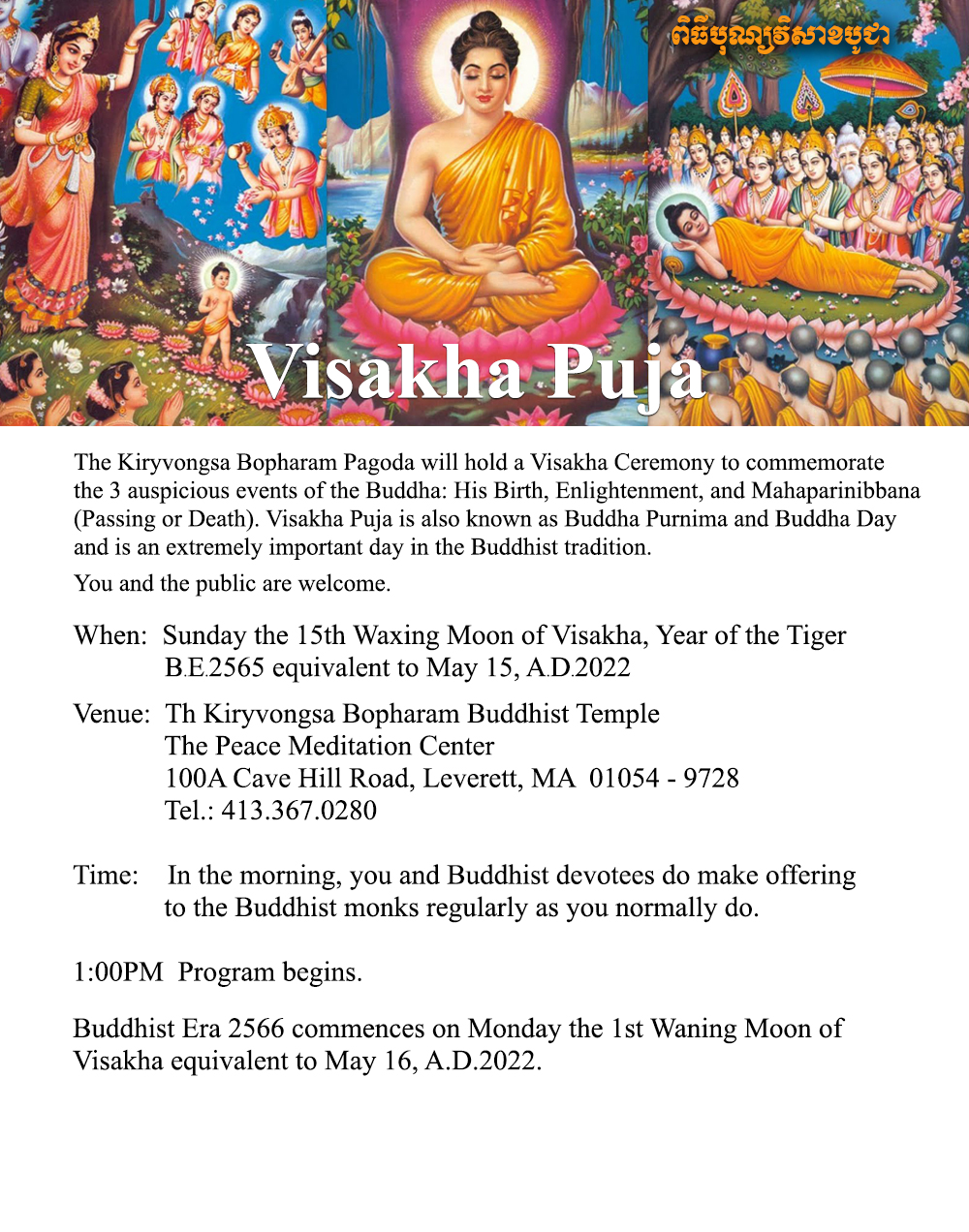
When: Saturday the 15th Waxing Moon of Visakha, Year of the Tiger, B.E.2565 equivalent to May 15, A.D.2022
Venue: The Kiryvongsa Bopharam Pagoda, the Peace Meditation Center
100A Cave Hill Road, Leverett, MA 01054 – 9728
Tel.: 413.367.0280
Time: 1:00PM
In the morning, you and the Buddhist devotees do make offering to the Buddhist monks regularly as you would normally do.
ពុទ្ធសករាជ ២៥៦៦ ចូលនៅថ្ងៃចន្ត ១រោច ខែពិសាខ ត្រូវនឹងថ្ងៃទី១៦ ខែឧសភា គ.ស.២០២២។
Buddhist Era 2566 commences on Monday the 1st Waning Moon of Visakha equivalent to May 16, A.D.2022.
សូមអញ្ជើញចូលរួមដោយមេត្រី។ សន្សំបុណ្យកុសលទាន់នៅមានកម្លាំង។ មិនមាននរណាសន្សំបុណ្យកុសលជំនួសមនុស្សណាម្នាក់បានទេ។
Please come join us. Earn your merits while you’re still able. No one earns merits on one’s behalf.
The Kiryvongsa Bopharam Pagoda celebrating New Year on April 14 – 17
វត្តគិរីវង្សាបុប្ផារាម ប្រារព្ធពិធីបុណ្យចូលឆ្នាំខ្មែរ នៅថ្ងៃទី១៤ – ១៧ មេសា
ថ្ងៃអាទិត្យ ៤រោច ខែមាឃ ឆ្នាំឆ្លូវ ត្រីស័ក ព.ស.២៥៦៥ ត្រូវនឹងថ្ងៃទី២០ ខែកុម្ភៈ គ.ស.២០២២
Sunday the 4th Waning Moon Māgha B.E.2565 equivalent to February 20, A.D.2022 Year of the Cow
Download Khmer PDF: New Year Khmer 2566 2022 ||English PDF: New Year English 2566 2022
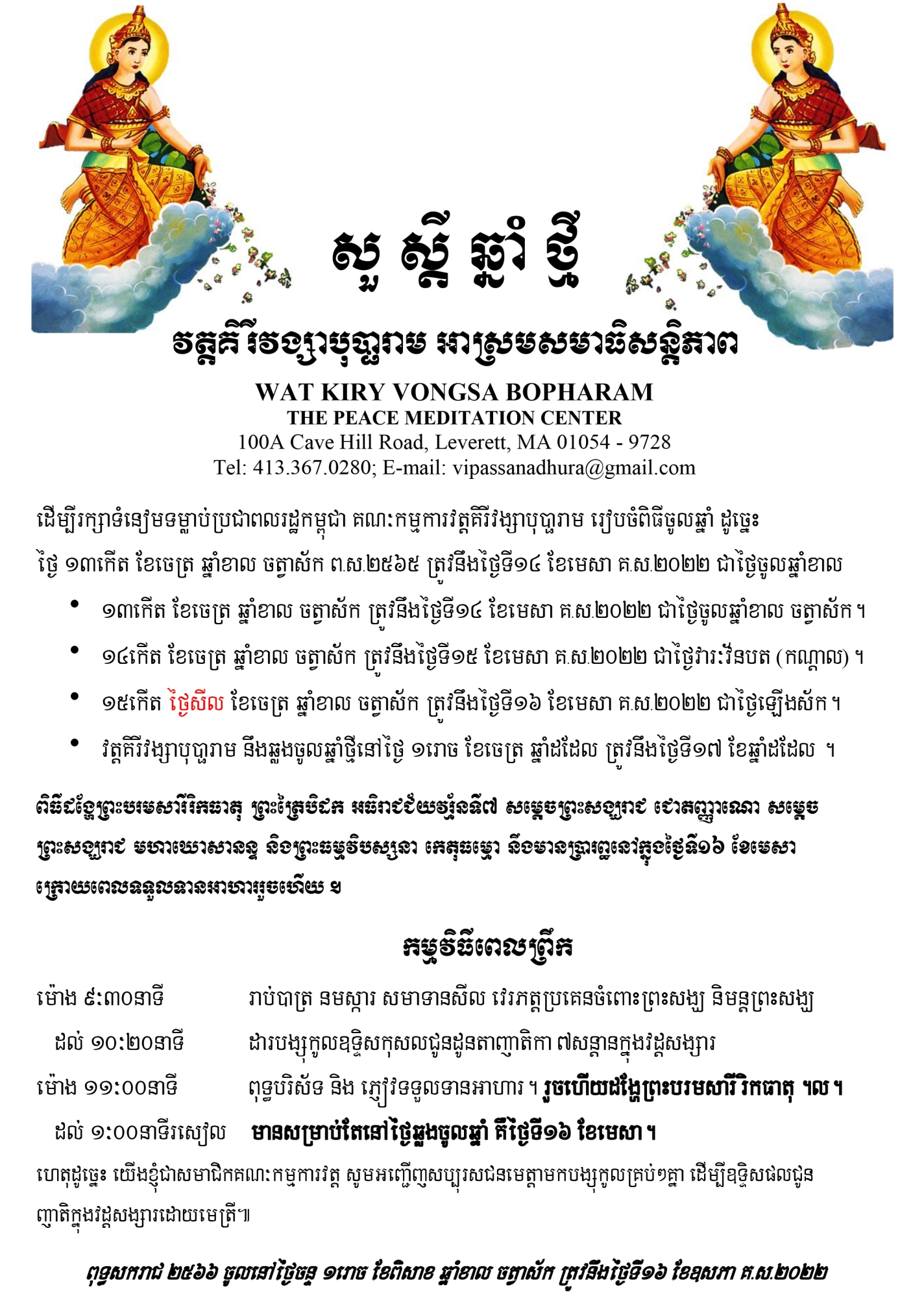
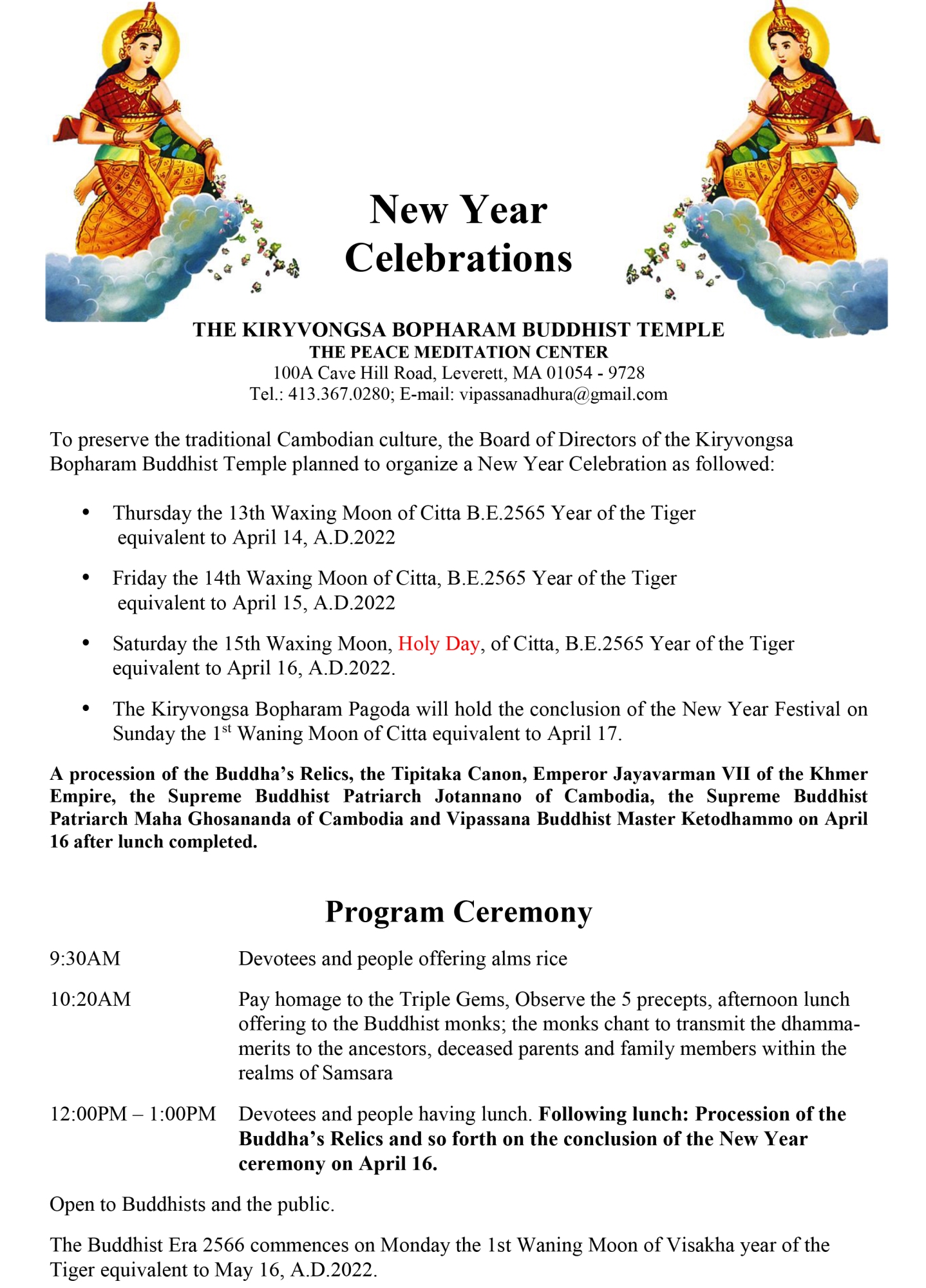
A 10-Day Meditation Retreats in Leverett, Massachusetts
រៀនធ្វើសមាធិ វិបស្សនា និងអប់រំចិត្ត
INTERESTED IN LEARNING MEDITATION
A 10-Day Meditation (Samadhi) & Vipassana (Insight Meditation) Retreats
ថ្ងៃអាទិត្យ ១៤កើត ថ្ងៃកោរ ខែបុស្ស ឆ្នាំឆ្លូវ ត្រីស័ក ព.ស.២៥៦៥ ត្រូវនឹងថ្ងៃទី១៦ ខែមករា គ.ស.២០២២
Sunday the 14th Waxing Moon of Phussa B.E.2565, January 16, A.D.2022 Year of the Cow
When: JUN 25 – JUL 06, B.E.2566 A.D.2022
Location: The Kiryvongsa Bopharam Pagoda, the Peace Meditation Center, Leverett, Massachusetts United States
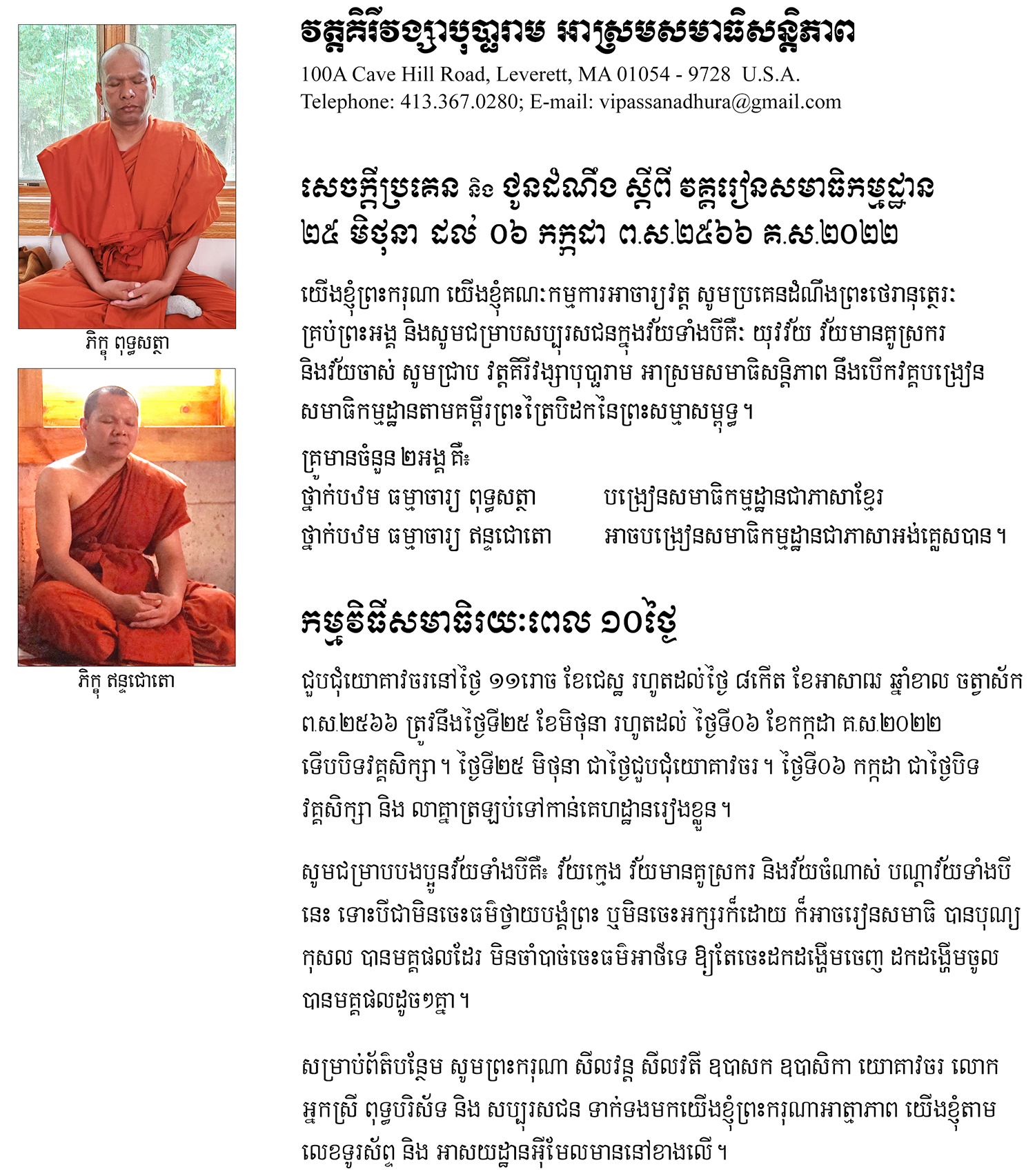
Vipassana and meditation teachers are: Bhikkhu Buddhasaddha, Bhikkhu Indajoto.
The meditation technique is taught strictly in accordance to the Buddhist Tipitaka (The Buddhist Canon).
To learn more about last year’s program. Click on hyperlink.
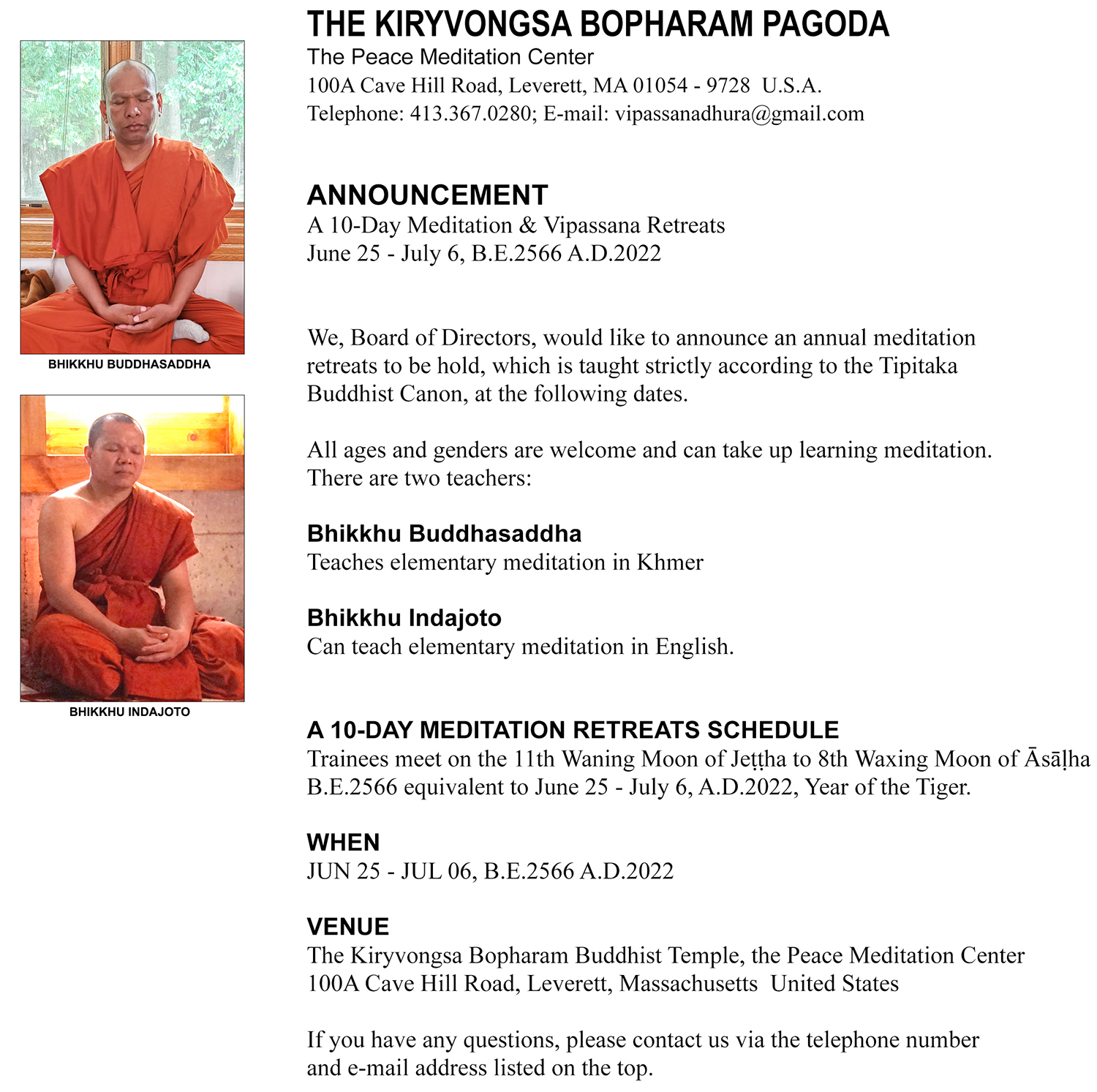
Modes of Transportation
By Air: You are suggested to stop at Bradley International Airport in Connecticut. It is a 1-hour drive to the temple.
By Land: You are suggested to stop in Amherst bus station if you arrive by bus from out of state or Canada. It is about a 25-minute drive to the temple.
Please DOWNLOAD PROGRAM and REGISTRATION FORM. Complete the registration form and send it back as soon as possible.
Download Khmer PDF: Registration
Download English PDF: RegistrationEN
Contact Info:
The Kiryvongsa Bopharam Pagoda, the Peace Meditation Center
100A Cave Hill Road, Leverett, MA 01054 – 9728 U.S.A.
Tel.: 413.367.0280
Advance ENROLLMENT opens
Māgha Pūjā at Wat Kiryvongsa Bopharam on FEB 16, 2565/2022
វត្ដគិរីវង្សាបុប្ផារាម អាស្រមសមាធិសន្ដិភាព នឹងប្រារព្ធពិធីបុណ្យមាឃបូជា នៅថ្ងៃពុធ ១៥កើត ពេញបូណ៌មី ថ្ងៃសីល ឆ្នាំឆ្លូវ ត្រីស័ក ព.ស.២៥៦៥ ត្រូវនឹងថ្ងៃទី១៦ ខែកុម្ភៈ គ.ស.២០២២
The Kiryvongsa Bopharam Pagoda, the Peace Meditation Center to observe the Māgha Pūjā on Wednesday the 15th Waxing Moon of Māgha, Day of Abstinence, B.E.2565 equivalent to February 16, A.D.2022.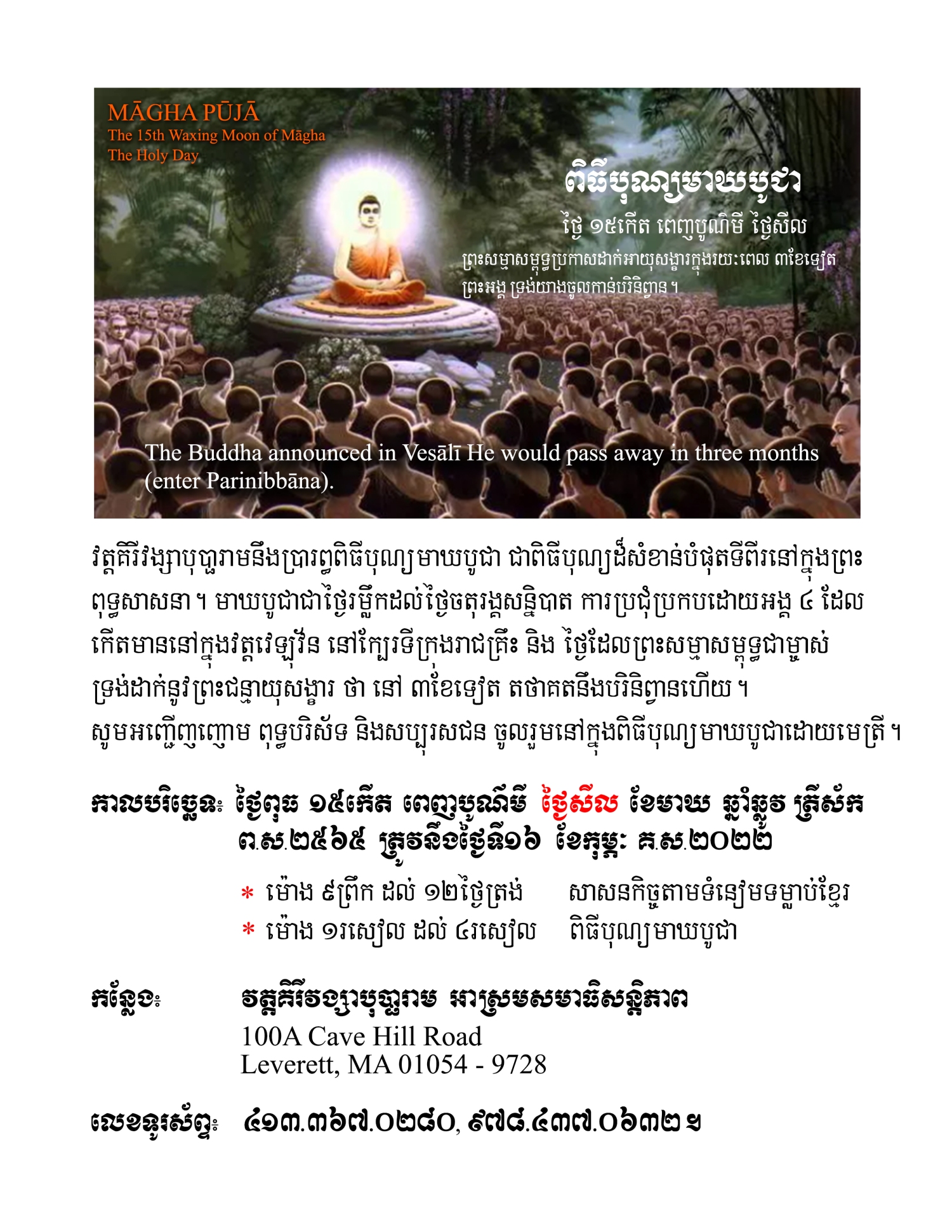
Venue: The Kiryvongsa Bopharam Pagoda, the Peace Meditation Center
100A Cave Hill Road, Leverett, MA 01054 – 9728
Tel.: 413.367.0280, 978.437.0632
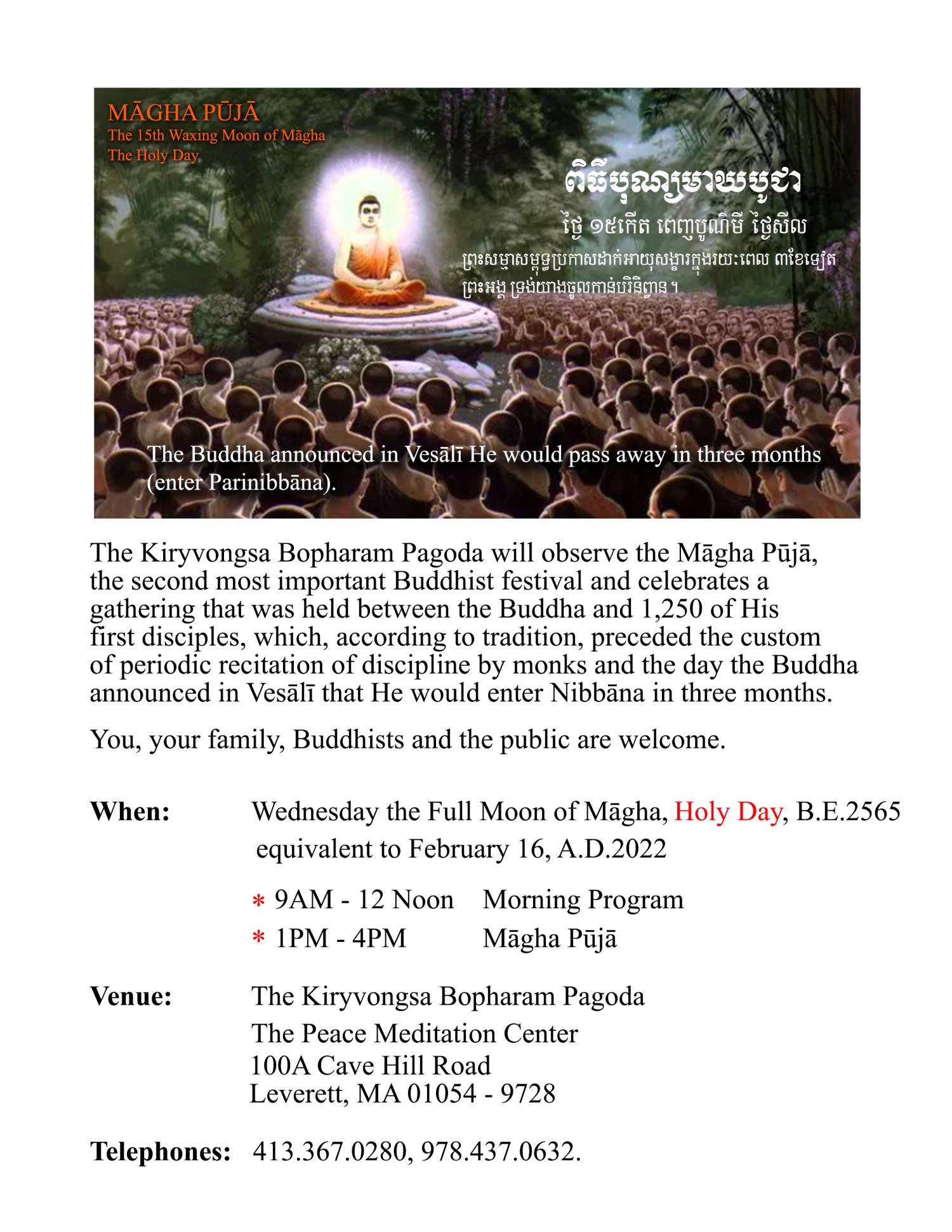 Background on មាឃបូជា Māgha Pūjā
Background on មាឃបូជា Māgha Pūjā
Māgha Pūjā is the second most important Buddhist festival, celebrated on the full moon day of the third lunar month in Cambodia, Laos, Thailand, Sri Lanka and on the full moon day of Tabaung in Myanmar. It celebrates a gathering that was held between the Buddha and 1,250 of his first disciples, which, according to tradition, preceded the custom of periodic recitation of discipline by monks. On the day, Buddhists celebrate the creation of an ideal and exemplary community, which is why it is sometimes called Saṅgha Day, the Saṅgha referring to the Buddhist community, and for some Buddhist schools this is specifically the monastic community. In Thailand, the Pāli term Māgha-pūraṇamī is also used for the celebration, meaning ‘to honor on the full moon of the third lunar month’. Finally, some authors have also referred to the day as the Buddhist All Saints Day.
Celebration of Māgha Pūjā is a public holiday in many Southeast Asian countries and is an occasion when Buddhists go to the temple to perform merit-making activities, such as alms giving, meditation and listening to teachings. It has been proposed as a more spiritual alternative to the celebration of Valentine’s Day.
Māgha is derived from the name of the third month in the traditional Indian lunar calendar, on which the celebration is held. It is also the name of a star, which during this period is close to the full moon. Māgha Pūjā is held on the full moon day. In a leap year, the celebration will be postponed to the full moon day of the fourth lunar month.
Māgha Pūjā day marks an event occurring at the Veḷuvana grove, near Rājagaha (present Rajgir) in northern India, ten months after the enlightenment of the Buddha. The traditional story goes that a meeting is held in the afternoon, that has four characteristics:
1,250 disciples come to see the Buddha that evening without being summoned; These are mostly pupils from the Buddha’s recently converted disciples, such as the three Kassapa brothers, and the monks Sāriputta and Mogallāna.
All of them are Arahants, enlightened disciples;
All have been ordained by the Buddha himself, and therefore are his direct spiritual descendants;
It is the full-moon day of the third lunar month.
Because of these four factors, Māgha Pūjā is also known as the Fourfold Assembly Day. On this occasion, the Buddha teaches those arahants a summary of Buddhism, called the Ovādapatimokkha. In these, three principles are given:
“The non-doing of evil / the full performance of what is wholesome / the total purification of the mind.”
This is followed by a formulation of Buddhist ideals:
“Patience (and) forbearance are the highest austerity. The awakened ones say nibbāna is the highest. One is certainly not a wanderer if one injures others; one is not an ascetic if one harms another.”
Finally, the last stanza is about the path of religious practice:
“Not abusing, not injuring, and restraint under the rules of discipline, and knowing moderation in eating, and secluded lodgings, and exertion in respect of higher thought, this is the teaching of the awakened ones.”
According to the traditional Pāli commentaries, the Buddha continued to teach this summary for a period of twenty years, after which the custom was replaced by the recitation of the monastic code of discipline by the Saṅgha themselves. On Māgha Pūjā, Buddhists celebrate the creation of an ideal and exemplary community.
Māgha Pūjā is also the day that the Buddha is believed to have announced in Vesālī he would die in three months, after which a miraculous earthquake followed. Moreover, in Sri Lanka, it is considered the day that the Buddha appointed his two main disciples, the monks Sāriputta and Moggallāna. Apart from the religious meaning, Māgha Pūjā also reflects the Southeast Asian agricultural year, as it is celebrated after the harvest.
It is unknown how traditional Buddhist societies celebrated this event in pre-modern times, but in Thailand, the first known instance was during the reign of the Thai king Rama IV (1804–68), who instituted it. He first held it in the palace only. In the evening, 31 monks would recite the Ovādapatimokkha, lit lanterns around the ubosot (ordination hall), and give a sermon about the same Ovādapatimokkha. A recitation text used for this occasion is attributed to Rama IV. Rama IV’s successor Rama V (A.D.1853 – A.D.1910) expanded the practice and organized it as a national celebration in the Temple of the Emerald Buddha. From Thailand, the practice spread to neighboring countries. Already in A.D. 1937, the ceremony was widely held and observed in Thailand.
Māgha Pūjā is a day that laypeople make merit. Monastics and devotees will hold processions, light candles, and make offerings. Māgha Pūjā is celebrated most extensively in Cambodia and Thailand, but it is a national holiday in most Southeast Asian countries, such as Laos, Myanmar and Cambodia.
In Thailand, Māgha Pūjā was instituted by Rama IV. It is currently designated as a national holiday, on which sale of alcohol is strictly prohibited. On the evening of Māgha Pūjā, most temples in Thailand hold a candlelight procession. Furthermore, people will make merit by going to temples and by joining in with activities, such as listening to teachings, giving alms, etc. At times, special events are also held, such as a recital of the entire Buddhist scriptures and ceremonies for avowing oneself as a Buddhist lay person. In A.D.2006, the government of Thailand made an announcement that Māgha Pūjā should be celebrated as a “national day of gratitude.” Māgha Pūja was therefore presented as a day of spiritual love and gratitude instead.
In Sri Lanka and Cambodia, Māgha Pūjā is also observed. In Chinese communities, as well as in Myanmar, a similar festival as Māgha Pūjā is observed. The Burmese people celebrate this on the full moon of the month Tabaung according to their traditional calendar. Fifteen days before this full moon day, a Shwedagon Pagoda Festival is held, on which a ceremony is held for offerings to the 28 Buddhas (from Taṇhaṅkara to Gotama Buddha), followed by a 10-day, continuous recital of Buddhist texts. Burmese devotees make merits and meditate during this period.
Māgha Pūjā has also become a popular event among Western Buddhist converts in the West. Wikipedia
ផ្សាយនៅថ្ងៃ ១កើត ខែបុស្ស ឆ្នាំឆ្លូវ ត្រីស័ក ព.ស.២៥៦៥ ត្រូវនឹងថ្ងៃទី៣ ខែមករា គ.ស.២០២២
Monday the 1st Waxing Moon of Phussa B.E.2565 equivalent to January 3, A.D.2022 Year of the Cow
MEDITATION DOCUMENTARIES
DHAMMA TALK BY VEN. KETODHAMMO
ព្រះធម្មទេសនាសំដែងដោយ ព្រះធម្មវិបស្សនា កេតុធម្មោ សំ ប៊ុនធឿន
Dhamma talk by the late and renowned Cambodian Vipassana Buddhist Master Ven. Ketodhammo Som Bunthoeun.
TEMPLENEWS TV SHOWS
Watch our shows on LTC – Channel 95
Broadcast hours | Fridays: 4 – 5 pm, 8 – 9 pm
Tuesdays 11 am - 12 pm
Email: templenewscast@yahoo.com
Phone: 978.853.9623
Website: templenews.org
Youtube: www.youtube.com/templenewstv
To find out more, including how to control cookies, see here: Cookie Policy
